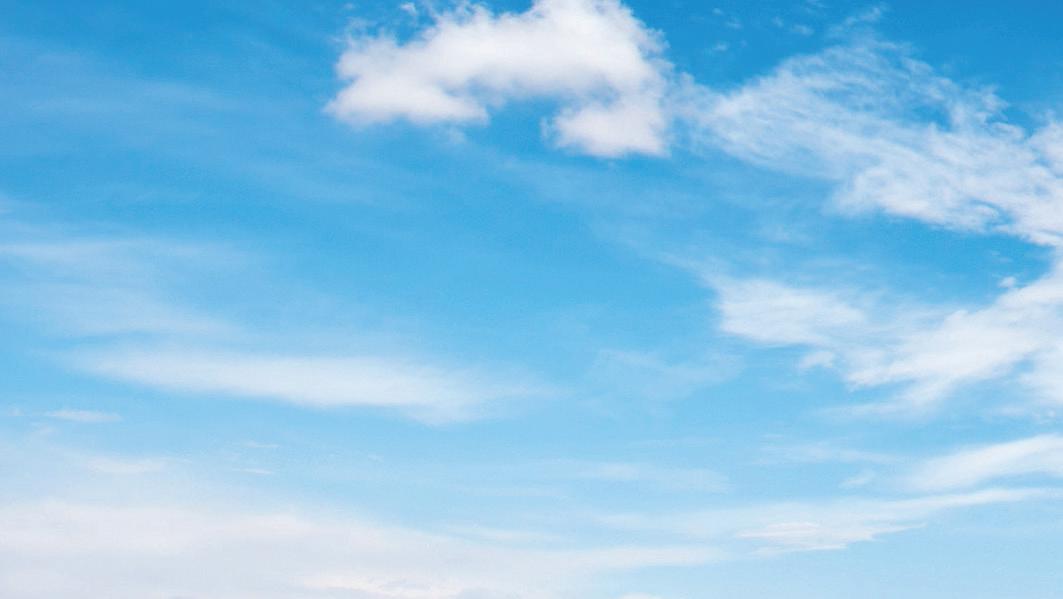



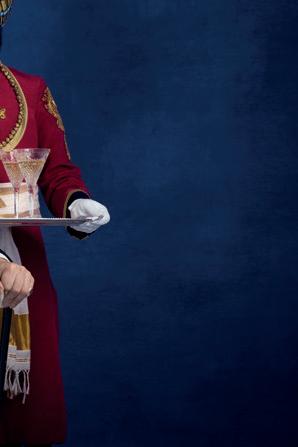










✓ 30c high ceilings throughout
✓ NBN 4 point pack



















































































































































✓ Choice of either Colorbond Roof or Roof Tiles from Builders range
✓ Two tone render for front elevation
✓ Ducted Reverse Cycle Air-conditioning
✓ 900mm kitchen appliancesrangehood, stove and oven
✓ Soft closing drawers and doors to kitchen and bathrooms


✓ 600m x 600m floor tiling to entry and main living areas
✓ Carpets to bedrooms and theatre
✓ Roller blinds throughout (excluding wet areas)
✓ Lighting Package (10 x downlights, 3 x pendant lights and 2 x pillar lights)
✓ Stone benchtops to Kitchen, Bathrooms, Laundry
✓ Kitchenette features - overhead cupboards, inset sink, fridge recess, stone benchtop

EDITOR
Rajni Anand Luthra
ASSISTANT EDITOR
Harshad Pandharipande
Puneet Anand, Nisha Joseph, Aneeta Menon, Kashif Harrison, Ritam Mitra, Aparna Ananthuni, Dhanya Samuel, Sanam Sharma, Vandana G, Preeti Jabbal
ADVERTISING
WA Sales Manager

Ram Naidu 0435 581 571
National Sales
Vivek Trivedi 02 9262 1766
ADVERTISING ASSISTANT

Charuta Joshi 02 9279 2004
EDITORIAL ASSISTANT
Beheshta Wasseh
Indian Link is a fortnightly newspaper published in English. No material, including advertisements designed by Indian Link, may be reproduced in part or in whole without the wri en consent of the editor. Opinions carried in Indian Link are those of the writers and not necessarily endorsed by Indian Link. All correspondence should be addressed to
Indian Link is a fortnightly newspaper published in English. No material, including advertisements designed by Indian Link, may be reproduced in part or in whole without the wri en consent of the editor. Opinions carried in Indian Link are those of the writers and not necessarily endorsed by Indian Link. All correspondence should be addressed to
Indian Link
few days’ notice.
BY PAWAN LUTHRAThere seems to be a prevailing mood among Indian-Australians that any bias, perceived or otherwise, against India or things Indian, will be met with a sharp rebuke and in certain cases, a call to action. This trend, which seems to have emerged over the recent past, has emboldened the community to take a more decisive stand on various issues. What, however, needs to be sifted through, is to be clear about which battles need to be fought, rather than to take affront on each and every issue.
The second and perhaps more extreme issue was the blatant disregard by the government-funded SBS on the sensitive issue of the geographical map of India. Its depiction of the entire state of Jammu and Kashmir as disputed territory did not go down well with the Indian community. What was surprising was that in spite of representations from the community, the Indian diplomatic corps in Canberra and even a letter of protest from Labor Member of Parliament Michelle Rowland, SBS dragged its heels over clearing up the issue. It was, seemingly, with much reluctance, that it finally corrected the online version of the map. As one writer to Indian Link pointed out, “It is funny that SBS doesn’t show Tibet as being disputed or occupied.”
Also on a regular basis, complaints come up about the inappropriate use of our gods and goddesses in commercials. Hinduism’s most-loved god Ganesha seems to be a favourite of advertising companies.
In his most recent appearance - in a Meat & Livestock Australia’s video adGanesha sits at a communal meal in which lamb is served. The idea had the local Hindu community up in arms, issuing a call to the Australia Advertising Standards ureau to an the o ending film.
Indian Link
Level 24/44 Market St, Sydney 2000 or GPO Box 108, Sydney 2001
Ph: 02 9279-2004 Fax: 02 9279-2005
Level 24/44 Market St, Sydney 2000 or GPO Box 108, Sydney 2001
Ph: 02 9279-2004
Email: info@indianlink.com.au
Fax: 02 9279-2005
Email: info@indianlink.com.au

This year alone, we’ve had a few instances which had the community up in arms. One was a Bollywood event at which the organiser included in his guest list an unhealthy mix of entertainers who had, in public, incited violence and terrorism against India over the unrest in Kashmir. Media pressure from India and strong opposition from the local Indian Australian community forced the organiser to call off the event with but a
This was not the only time SBS got it wrong where the Indian community was concerned. Its earlier reports about PV Sindhu and AAP both turned out to be inaccurate and resulted in SBS having to apologise.
A juggernaut like SBS with an annual budget of over $280 million needs to be more aware of its responsibilities towards the multicultural communities it claims to serve, and a more robust internal compliance system.

Earlier this year, the company Raven Fightwear was urged to withdraw its rashvest which displayed images of a “Battle of the Gods - Hanoman v Ganesha.” Flow Yoga Wear were also forced to withdraw from sale their leggings depicting Lord Ganesha’s form. While these issues are important and a balance needs to be kept between sensibilities and shock value, perhaps we also need to see similar passion on other issues which affect the community more directly. The community moral muscle needs to e fle ed against domestic iolence, seniors’ financial a use and other social justice issues. By being strong internally as a community, we can harness our strengths to effect citizen action against those who cause affront to us as a whole.


The community reacted to the Meat and Livestock Australia ad that has caused a lot of controversy
Janaki Rathod wrote: Yes it is offensive and unecessary. Most of the Indians are vegetarian and eating meat is any way not a good idea for many spiritual people. The important fact is you are killing an animal, so how can it be good? Shame on these ad makers and people who even considered it funny.
Ruchika Bhasin wrote: I do like the fact that all religions are sitting together and having a meal. What I don’t like is the fact that they completely ignored the sentiment of both Hindus and Muslims. At the end, they speci cally mention lamb that everyone can enjoy, which con rms that they are ignorant / purposely want to ignore religious beliefs of people. Just shows how the socalled creative minds of ignorant people work.
Mayank Ashri wrote: Dear @MeatAndLiveStockAustralia




The recently released ad depicting Hindu God eating meat is highly inappropriate and almost offensive towards people’s sentiments
Payal Gupta wrote: We should not make it an issue to outrage the religious sentiments of people. But yes, it needs to be resented. Any personal attack on any community or culture, above all any religion is objectionable. We have various other ways of publicity. Why adopt a way which can hurt and agitate the concerned masses?
Rajni Luthra wrote: I thought the ad was quite clever: it showed that we must all come together irrespective of our religious differences. Many vegetarians sit at tables where meat is being served without raising a ruckus. I wonder if Ganesh himself would have minded – whether he partook or not. Might be important to remind ourselves of what Ganesh’s pot belly really represents: it is a symbol of the brahmanda, the entire universe and its illusory quality to encompass everything good or bad.
Smriti Yadav-Vig wrote: The current world we live in is too sensitive, be it Hindus or other community groups. I’m a Hindu and no I’m not ‘offended’.
Roopak Kumar wrote: This is absolutely disgusting. It’s ok to have bit of fun but it’s not acceptable to play with people faith and on top misleading facts.
Chandra Kishore wrote: It is insulting. There is a petition going on… we should sign it.



Pranav Aggarwal wrote: Totally condemn and would sign the petition.
Jyoti Kapoor wrote: Shameful! No one is standing properly
Our story on organ donors and recipients struck a chord with many Life Giving Stories wrote: Thanks Farzana Ahmad from Indian Link for your coverage of Life Giving Stories 2017. One of the best lines came from Milli Udani: “If receiving an organ is not forbidden in any religion, then why would it be not permitted to donate one.
Rajni Luthra wrote: Alan, so good to hear you speak so candidly. You sound like a really cool dad, a great guy, and a wonderful family man. I’m sure you’ve convinced many, in your quiet, sage way, to vote Yes! Hope to keep hearing from you on the issue.

Indian Link hosted former diplomat, writer and politician Dr Shashi Tharoor for a private dinner with a select gathering. They couldn’t stop gushing about the dynamic guest


Shashi Tharoor tweeted: My third event of the day in Sydney. Enjoyable dialogue
Monika Barthwal Datta tweeted: Great evening listening 2& engaging with the brilliant @ShashiTharoor over dinner hosted by @indian_link
Yadu Singh tweeted: At an interesting, informative and enlightening evening with @ShashiTharoor, organized by @indian_link at Manjit’s, The Wharf, Sydney.
Charu Menon tweeted: Fan girl moment!! Thank you @ShashiTharoor for a riveting evening. Eloquent as ever. Come back to Sydney soon. #sydney #IndianLInk #sigh
Fida Saxena tweeted: Dear sir you are one of the most eloquent speakers in present times
Indian-Australians expressed anger over depiction of the entire Jammu and Kashmir state as disputed territory Karthi Keyan wrote: It is funny that SBS doesn’t show Tibet as being disputed or occupied.

Our Facebook post on the Bollywood-inspired celebrations of India’s 70th Independence Day was well-liked Kerren Lumsden wrote: Would love to be able to dance like this....
An Indian Link advertiser SARAH GILLIS dug out an old copy of the newspaper and refreshed some memories
“Live and Work in Australia with Sarah’s help!” This advertising supplement from Indian Link newspaper way back in 2000 celebrated me opening the doors to my own business!


And my doors are still open today. Come and have a chat.
#ThrowbackThursday #Throwback #25Years #SilverYear #tbt
This is the man the British want us to hail as an apostle of freedom and democracy, when he has as much blood on his hands as some of the worst genocidal dictators of the 20th century Shashi Tharoor on Winston Churchill ABC TV’s Q&A
The excuse that apologists (of British empire) like to make is, it’s not our fault, you just missed the bus for the industrial revolution. Well, we missed the bus because you threw us under its wheels Shashi Tharoor on ABC TV’s Q&A
Raj Gondaliya was at the right place at the right time when he and his wife met Aishwarya Rai Bachchan. Raj shares his experience
We all know Aishwarya as an actress, but I can add that she is a humble and warm person as well. As she was about to go for an interview with Rajeev Masand, my wife and I asked her for a photo with her and I can’t believe how considerate she was. She didn’t want us to wait till her interview nished so she asked us to come forward to pose for a photo before it. We had an opportunity to have a quick chat with her, and it was a pleasure talking to her. She’s been in the industry for long but is still grounded. It was also good to see Aaradhya with her during ag hoisting ceremony. She is a hands-on mother, balancing her work life and personal life well. I think it’s inspiring how she has maintained a digni ed status as a daughter, daughter-in-law, wife, mother and above all - a woman.

The lm ‘Lipstick Under My Burkha’ gets applause for its frank portrayal of female sexuality

Aparna Ananthuni wrote: “Let’s at least have sex?”




This is one of my favourite moments from Lipstick Under My Burkha, this year’s most ‘controversial’ Indian lm.
Leela, a young beautician who is being forced into an arranged marriage, has snuck over to her moody boyfriend’s house in the middle of the night, where he is sleeping with some young boy relatives. They go into the bathroom to have sex, argue, and the boyfriend, Arshad (played by Vikrant Massey), makes to leave in the middle. That’s when Leela asks her question, panting and unsatis ed.
Arshad’s answer encapsulates, in all its ugliness, just what Indian women face when it comes to expressing sexual desire.
“Is that all you want? Sex?” He spits. He then yells that he’ll bring the two sleeping boys in if that’s what she’s after. In one moment, he’s made her lust, her urge, her natural sex drive, into something perverted, unnatural. Why has Lipstick been called ‘controversial?’
Because it tells us that Indian women want to have sex.
It’s nothing more, and nothing less.
It shouldn’t be revolutionary, and it certainly shouldn’t be revelatory, but that’s exactly what it has become. Indian women want to have sex, and that is too shocking a fact not to stir up a ruckus.
It may have been banned for being too “lady-oriented”, but the fact is, what that really translates to is, “no male gaze”. Forsooth!
Because Lipstick tells us, rightly, that sexual repression and freedom from patriarchy go hand-in-hand. Four women, of an assortment of ages and lifestyles, is each shown playing out her own relationship with sexuality and oppression. The youngest, Rehana (Plabita Borthakur), is a college student who breaks free of the burkha forced on her by her parents, and has her rst brush with love, lust and heartbreak. Leela the beautician (Aahana Kumra) is caught between obedience to her single-parent mother, her fun and sexually satisfying relationship with Arshad, and the nagging sense that she shouldn’t have to choose between having fun and being poor and disrespectable. Shireen (Konkona Sen Sharma) is a secret door-to-door sales superstar, but has to grimly endure nightly rape from her emotionless, lazy pig of a husband. And nally, Usha (Ratna Pathak), called ‘Buaji’ by everyone in town, known as an upright ‘elderly’ widow who runs her family business with a rm hand, begins to have secret and highly pleasurable phone sex with her hot young swimming instructor, with devastating consequences.
I suspect those who nd the lm underwhelming simply don’t understand what the fuss is about. But that’s exactly the point.

A reader, DHAMAYANTHI SIVA, wrote in, saying she was ‘scammed’ by a ticketing website
I wish to alert all fans of AR Rahman who are thinking of buying tickets to his concert about something of a scam that is currently operating. A few days ago, I found a website called Viagogo to book the tickets. I chose the middle row to get a good view of the stage and the website advertised these tickets at $222 each. We paid a total of $1,151. But yesterday, I received the tickets (via email) which had a face value of $132 each. Further, the seats that were allocated were quite far from the stage. So I will have to bring sets of binoculars to see AR Rahman on stage!
I got in touch with Viagogo straight away. Their response was that they will not be providing a refund or exchange. They did offer a re-sale using their website. But there was no mention of method of resale or price. Surely this is not the idea of organising a concert.
Australia is one of my fav holiday destinations. I’m fascinated by its warm and welcoming people, spectacular nature, unique wildlife, world-class food Parineeti Chopra, on being appointed ‘Friend of Australia’

To be an Indian feminist woman, even one living in the diaspora, and to watch Lipstick, is to feel like a breath has been released. One that has been held for a very, very long time.
Women want sex. Good, consensual, pleasurable sex. And they want it because it feels good.
+ JOIN THE
> LOG on to your own Facebook or Twitter account
> TYPE “Indian Link” into the search box at the top of the screen and click on the link that comes up

> CLICK ‘Like’ to join the Indian Link Facebook community or ‘Follow’ @Indian_Link on Twitter


Jugaad: Hindi for clever, low-cost solutions.

Innovation is not only for wealthy economies #ABWI
Austrade’s word of the day a few days ago

Our trade and investment ties with this important partner (India) are becoming stronger each year
Asst Minister Keith Pitt on Aus Biz Week in India

The Consulate General of India in Perth organised not one but two remarkable celebrations of India’s 71st Independence Day this year. hese included the flag hoisting on the Consulate’s own premises in the morning, and a gala cocktail event in the evening.


he first was the annual flog hoisting in the morning, which many community members like to attend regularly. This time round, some 150 people turned up. Consul General Amit Kumar Mishra unfurled the beloved tiranga and the congregation sang the national anthem with much pride. He then read out the President Ram Nath Kovind’s message to the community, in which the new Head of State urged all Indians to work with the sense of unity, purpose and selflessness. e ela orated on the concurrent focus of the Indian Government with the Indian community abroad to strengthen the connection and also mentioned a few recent initiatives. These included programmes of development like Swachh Bharat; building or helping build toilets to make India open-defecation free; promoting Beti Bachao, Beti Padhao to ensure our daughters are not discriminated against; demonetisation; pushing transparency and eliminating corruption in public recruitment and procurement, and implementing GST to eliminate multiple taxes and simplify transactions.
The Consul General invited the Perth-based Indian community to join hands in achieving Prime Minister’s vision of “New India by 2022”. He also stated Consulate’s efforts to broaden and thickening of the bond with the

Indian community in Perth.

The dignitaries attending the event included two Indian-origin members of Western Australia Parliament, Yaz Mubarakai MLA and Kevin J Michel MLA, and Mayor of Cockburn city, Logan K. Howlett.
Both parliamentarians highlighted their journey from India to Western Australia’s Parliament. They promised to work for the betterment of the Indian community in the state and to strengthen India-Western Australia engagement.
Indian organisations active in Perth presented a cultural performance with patriotic songs. Refreshments were served as morning tea.
The evening reception was held on 16 August at The Government House Ballroom. It was a gala ceremony attended by some 200 high profile guests and riends o India in the wider community. The Governor of Western Australia Kerry Sanderson AC, Premier Mark McGowan, Chief Justice Wayne Martin AC, and the Lord Mayor of the City of Perth isa ac fidi were main guests, each gi ing powerful speeches. The Minister for Tourism, Citizenship and Multicultural Interests Paul Papalia CSC MLA, and the Minister for Mines and Petroleum Bill Johnston also were in attendance, along with Tony Krsticevic MLA, who represented the Leader of the Opposition. Other attendees included political leaders, o ficials, academicians, businessmen, media persons, members of Consular corps, and representatives of Indian community organisations.
Artists from Chennai School of Dance and Narthanalaya School of Indian Classical Dance presented fusion dance and Bharatnatyam.
It was great to see the interest in India in the mainstream, not only at the political and diplomatic levels but also at personal levels, including the manner with which India has been able to reach out with its soft power.





Dr Shashi Tharoor may be an Indian parliamentarian and a former minister, but he is also a globally renowned writer and orator. Known for his astute diplomacy at the UN for nearly three decades, for his insightful views on politics, history and international affairs, and for his scholarly books on these and many other subjects, Tharoor is a much sought-after personality wherever he goes.
Which is why, it was a very special evening when Indian Link hosted Dr Tharoor for a private dinner with a select gathering of guests from Sydney’s business, social and journalistic circles on 3 September. Dr Tharoor was in Australia to participate in the Melbourne Writers’ Festival and some events in Sydney to speak about his latest book Inglorious Empire: What the British did to India.
In a freewheeling conversation with Indian Link Media Group CEO Pawan Luthra at Manjit’s On The Wharf overlooking Darling Harbour, Tharoor opened up on a wide range of topics: from British atrocities in India, contemporary Indian politics, religious polarisation across the world and his experiences as a politician. Later, he freely mingled with the guests, signed copies of the book and posed for photographs.
It was an evening that fully lived up to its name: Thoroughly Tharoor. Here are excerpts from Pawan Luthra’s interview.
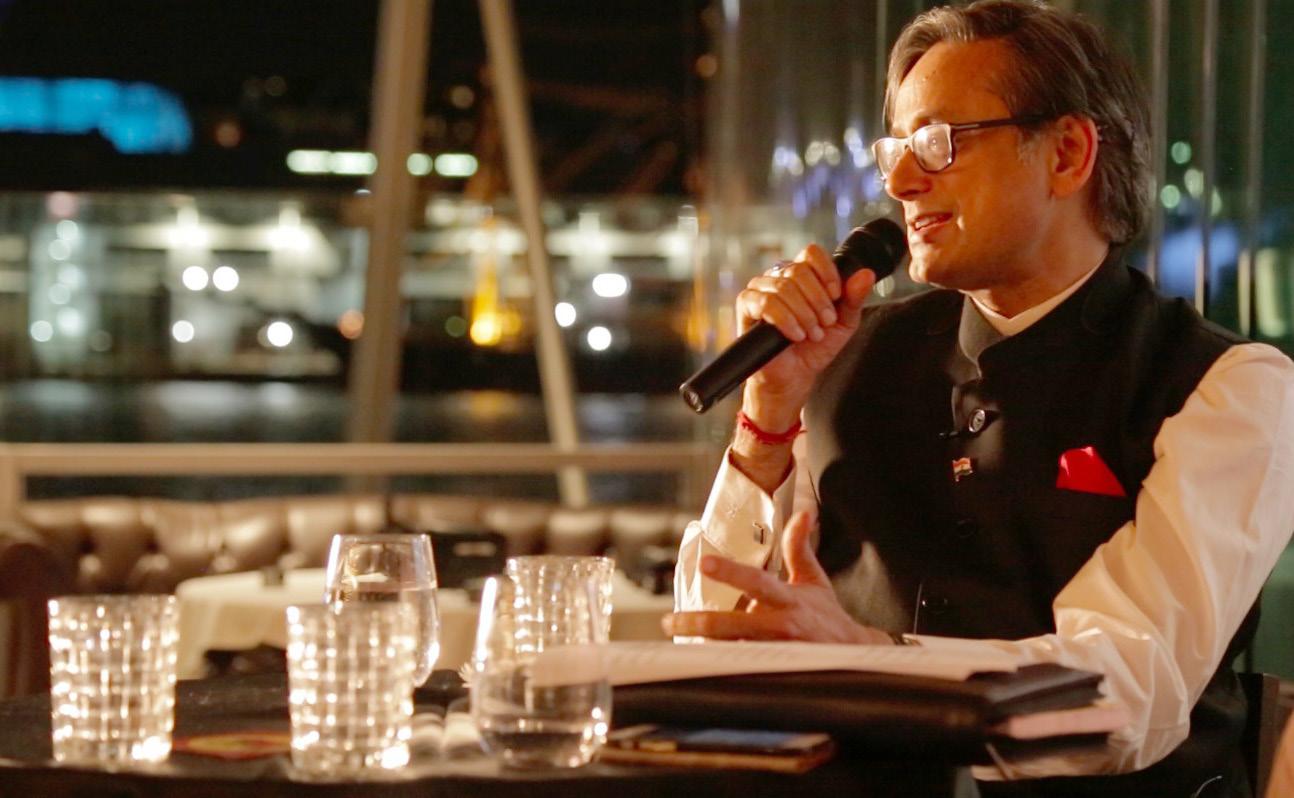
Q. This is your fifth visit to Australia. What appeals to you about Australia?
Also, what has surprised you about it?
A. It’s a great country. The sun shines a lot. For me, this particular visit is special because of the interest that book appears to have generated. What has surprised me is that this has coincided with your internal debate about the legacy, the statues, in a society that is increasingly conscious of itself as multiracial, and that is fascinating. I remember the days not long ago when Australia had a white Australia policy, when politicians could openly say things like ‘Two Wongs don’t make a White,’ and where one saw Australia rather set in a particular view of itself, and which has changed dramatically in the last generation.
Q. There are obvious parallels between the colonisation of our two countries, and the issue of ‘righting’ of history is hotly debated here as well, just at the same time as your own book comes out. What are your thoughts there?
A. My part in it is entirely coincidental. I happened to be invited to Oxford University (in 2015). Somehow, the speech there about Britain owing India reparations captured the imagination of Indians and Indian diaspora. When it went up on the internet, it was downloaded 3 million times in the first hours. In ngland, they have agreed to teach a different version of history at the university. It’s shocking that you can do A levels in history today without learning colonial history and I think it’s important that they do that. I have also pointed out that a city full of museums doesn’t have museum to
colonialism. It’s shocking that there isn’t a place where school children or foreign tourists can go to see the history of the British engagement in the World War. It’s all brushed under the carpet. And it’s replaced by these gauzy romanticised soap opera type shows, which reflect a distorted view of the reality and cut out the Indians who were colonised. It’s certainly time for people to wake and smell, not the coffee, but the spices.
Q. Do you think that with Brexit, parts of this history would be even more brushed under the carpet?
A. Paradoxically, the opposite has happened. When Brexit happened, a bunch o nglish o ficials, some ci il ser ants and some people close to the ruling onser ati e arty, floated this i arre notion that it didn’t matter that Britain was leaving the EU because they would resurrect what they called Empire 2.0. I was in the UK at the time and said that given the fact that Empire 1.0 was such a bad idea, who would think Empire 2.0 would be resurrected? Moreover, the terms of trade available then won’t be available now. When the East India Company came to India, they started trading. And then they realised that it’s far easier to trade at the point of the gun. Now this is not possible between two sovereign equals. This scuttled their case quite quickly.
Q. Much of what you have written in the book, we in India have known for many years. Non-Indian readers have
been shocked at the atrocities that the British committed in India. What are some of the responses you have got from outside India?
A. It’s too early to speak about the global response, but the response from the UK and Australia is instructive in many ways. The Pakistanis seem to have related to it as well. (Former cricket captain and politician) Imran Khan called me to say how much he enjoyed the book. That kind of resonance in the subcontinent is not surprising. But in Britain, for example, what you’re seeing is an interesting paradox. There was a wonderful column in the London Times praising my book and saying that every Briton should be ashamed of its record in India. The pushback came from an Indian there. It’s interesting that the brown-skinned Britons felt more obliged to defend their Britishness. During a conversation, one person said that, “As a true Conservative, I believe we should have traded with you and not conquered you.” He said no Englishman can be anything but apologetic for what the British did to India.
Q. You seem to have set a date for possible positive action from the British for an apology, April 13, 2019, the 100th anniversary for the Jallianwala Bagh massacre. For our non-Indian guests here, can you give us a background to this horrific incident in history?
A. The Jallianwala Bagh massacre took place on April 13, 1919, and in many ways
was emblematic of the worst of the Raj. India supported the British in World War I. And it did so at tremendous cost. Taxpayers and rajahs contributed to the war effort. 1.3 million Indian soldiers fought for the allies. 76,000 of them perished in the cause. In fact, it can be argued that without Indian help, Britain wouldn’t have been able to fight orld ar I. he reason nationalists supported Britain in the war is because they were led to believe that the reward for their support in the Great War would be what they called progressively responsible self-governance. By this, the Indians assumed that they would get the same white dominion status enjoyed by Australia, New Zealand, Canada and South Africa. But the British, true to form, broke their promise and reimposed on India the wartime restrictions on freedom of speech, freedom of assembly and so on. This triggered protests within India and the British sent generals to various parts of India to quell the unrest.
eneral yer imposed ection (prohibiting the assembly of more than fi e people in mritsar. hat he didn’t realise that this was the time of the Punjabi festival of Baisakhi. Many men, women and children from Amritsar and surrounding villages had gathered at Jallianwala Bagh to celebrate Baisakhi. Dyer didn’t issue them a warning, didn’t fire a warning shot. e ordered his soldiers to fire directly into the bodies of the unarmed men, women and children. The only entry and exit gates were barricaded because as he explained later this would make people easier targets. They fired , ullets that day. ery ullet hit a human being. The British claimed 379 people died. The Indians claimed 1,000. The real number is somewhere in between.
And that wasn’t even the end of the tragedy. Dyer closed the gates and forbade any relatives from attending to the injured and they lay dying. Of course, there was an uproar after this. The House of Commons condemned Dyer. However, the House of Lords passed a resolution praising Dyer. A collection was raised to reward him. The equivalent of a quarter of a million pounds sterling in today’s money was given to him as well as a bejewelled sword. He was hailed as the man who saved India.
So, the broken promises of World War I, the brutality of the massacre, the racism and indifference to the Indian suffering that ollowed and then the ustification o it, put together makes the Jallianwala Bagh massacre seem to me as the worst atrocity of 200 years of the British rule.
What my suggestion is that if a member of the royal family could come to Jallianwala Bagh on April 13, 2019, and sink to their knees in apology and regret for what was done in that place 100 years ago, it would have a cleansing effect on these 200 years of imperial sin. Is it likely to happen? Extremely unlikely. Some very senior friends whom I can’t name have told me that ‘If we apologise to you lot, we will have to apologise to many other countries.’

But I hope some of this will create some sort of consciousness about the issue.
Q. Retrospective rationalisation is a way of agreeing/disagreeing and reviewing the past and using the narrative to suit your present position. If we were to look at this decade in a 100 years’ time, who do you think will be asking for apologies from whom?
A. (Laughs) Don’t know where the list would begin! I’m sure there are Iraqis and other Arabs who would be asking for apologies from those who intervened in their country. Many innocent human beings will be asking the Islamic fanatics to apologise for what ISIS and Al-Qaeeda have done. Perhaps there will be a largish number of Americans who will be asking the descendants of Donald Trump to apologise!
Q. We’ve just celebrated Onam, a festival that is celebrated across religions. Is there a message in it for today’s religiously polarised times?
A. Very much so. In fact, what’s striking in the Kerala context is that it is a state in which people of different religions have coexisted for long. It has the world’s










oldest Jewish diaspora. It also has the world’s oldest Christian population outside Palestine because St Thomas came to Kerala around 52AD. Onam was a Hindu religious festival but today it is a festival owned equally by all communities. There is no sense among Christians and Muslims, who make up 25% each of the state’s population, that the festival has Hindu origins. For them, it’s their festival too. So, there is a lot of sharing, gift-giving and celebrating.
Does that have a lesson for the rest of India? Of course, it does. We are living in a time when those who have come to power have unleashed a set of unpleasant forces that have felt empowered by the ascent of the Hindu chauvinistic party at the centre. They are therefore preaching a very sectarian view of what India is all about and that is not at all in consonance with what it has stood for.


Q. There is a crisis of leadership all across the world, including, with respect, within your own Congress party. There is increasing polarisation in the communities in the US, Europe, India and even Australia. Surely you would expect that the more developed we get, the differences should fade away?

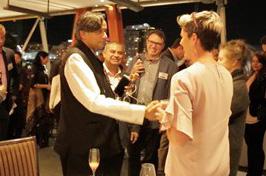
A. Well, it’s not happening, is it? Politics is polarised everywhere: France, the Netherlands, Hungary, Brexiteers in the UK and, of course, Donald Trump in the US. There are two kinds of backlash today. One is against globalisation; because globalisation has produced winners and losers. The losers are saying, ‘Why should we vote for the people who are sending our jobs away?’ So that’s the economic backlash.





My suggestion is that if a member of the royal family could come to Jallianwala Bagh on April 13, 2019, and… (express) regret, it would have a cleansing e ect
The other is a cultural backlash, which only partly o erlaps with the first. It’s a rejection of the globalised, cosmopolitan, sophisticated elite in favour of a nationalism that seems more authentic and more rooted. Mr Modi, for instance, participates in the cultural backlash, but (he rejects) the economic backlash. That’s because the Indian economy needs globalisation.



On leadership, it partially depends on the system. We don’t have a presidential system and were saddled with the parliamentary system. The Prime Minister is simply the leader of the party that happens to get the most number of votes rather than the most popular individual in the country. If we talk about one leader against another, we are playing into Mr Modi’s hands, because he is this largerthan-life leader on a white horse, charging down on his stallion with his sword upraised and who knows the answer to all questions. My point is that he may be that, but why must we offer him another leader on a white horse? Why can’t we ha e a deep ench o ualified and experienced people who can listen to you and understand your problems, rather than a person who says he knows the answers to all questions, but hasn’t delivered much at all in the last two years?

Q. You were one of the earliest adopters of social media among Indian politicians. But there isn’t much of nuance left in the social media discourse. Is it still a valuable medium of communication for politicians?


A. Very much less so than when I started.



I adopted Twitter when none of the Indian politicians were doing it. In a few years, the opposition got onto Twitter. It is almost obligatory to be on Facebook. There are 200 million Facebook users in my country and there is no question of ignoring that. But social media doesn’t have the same utility as it earlier had because initially, you were interacting with real people. You posted genuine thoughts and got genuine responses in the form of comments, banter and so on.

Now, there are so many organised hounds. The BJP has so many of the online cells. On a marching order to a cell, accounts tweet the same message against you. The other phenomenon is a troll who is abusive for a politician like me who has a point of view on everything. Opening up my timeline is a deeply distasteful experience because 80% of the tweets addressed to me are abusive. So all of this has made it less useful than it used to be.
Now, even Twitter trends are manipulated where entire armies of people instruct others to tweet a particular hashtag so that it becomes a trending topic. This has made it much less useful for a person like me looking to engage with the general public.
Q. How do you strike a line between acknowledging history and not be







mired in endless grievances of each side involved in that history?

A. The only way to reconcile the two is y actually finding common ground. At the Sydney Opera House and at the Melbourne Writers’ Festival, people began by acknowledging the land, its traditional owners and so on. There is a danger that this can descend into tokenism or a ritual devoid of meaning, but right now, I get the sense that it means a lot. The majority can acknowledge that there was a historical wrong done which is impossible to undo, but there is a moral case that it needs to be acknowledged. Both the colonised and the coloniser will need to acknowledge something of the other side.
Q. In a democracy, we need a strong leadership and a strong opposition. But because the opposition is not very powerful (in India), the ruling party is having its own way. Why is it that the opposition, particularly Mr Rahul Gandhi, has not been able to counter the government effectively?




A. I recognise that this is a widespread perception. As a loyal Congressman, of course, it don’t share it. I know that Rahul Gandhi is not the dumb guy that is caricatured in the media or WhatsApp. But once a brand has been tarnished that way, it takes a long time to recover. What I do know is that it is important to have a deep bench strength. For example, the BJP had a ca inet reshu fle today and out o the nine new ministers, four are ex-bureaucrats and two had to be nominated to the Rajya Sabha. It should be concerning that the
ruling party that came to power with a crushing majority doesn’t have enough talent to form a cabinet of ministers. On the other hand, in the opposition, there is a galaxy of people that are experienced and have served the country.

When it comes to elections, we should acknowledge the political mathematics that the only way we can come to power (in the near future, to defeat the BJP) is through a coalition.
Q. Is there a danger of Indian and Chinese imperialism that will affect the world in the 21st century?

A. Quite frankly, we have been outpaced by China. While both started from the same place in the 1970s, China is far ahead. The race is over. My bigger worry is China and the US forming a sort of G-2 which would be a disaster for the world. As far as we are concerned, we still have 26% of the population below the poverty line. hile we ha e progressed rom when the British left us with 90% of the population below the poverty line, this 26% is still 26% too many. As long as we can provide each citizen with proper education, health care and jobs, we should be happy. It is not a zero-sum game. India and China can both prosper in their own way.
The danger, I feel, is not an India-China imperialism but rather an unnecessary hostility between the two nations.
Q. In the 190 years of British occupation of India, what may come out as their biggest achievement is that laid the foundation of one
country. Looking forward, with more than 25% of the population not understanding the language spoken in New Delhi, how do you see the future of India in the very long term?
A. I think India has actually grown closer over the years. There is more and more in common in terms of religion and culture. Look at the Indian cricket team, for example, and its uniting effect on the country. Now, you get masala dosa in New Delhi, and salwar kameez has already overtaken the sari as the most popular attire in South India. So there is much more integration now. There was an unnecessary ker u fle caused y some members of the BJP recently over Hindi as the national language, whereas it is the o ficial language, apart rom nglish. There were some calls on Twitter for a separate state to oppose this, but they quickly died down. The big advantage India has as one country, is that it’s a larger playing field or e ery ody, an open market, a stronger economy and military. So I don’t think it’s under threat at all. Kashmir is a protection problem, but I see greater clamour from the North-East for acceptance in the mainstream.
Q. We have adopted the democracy system and you have said that it is perhaps not the best system. What system in your view is the best system?
A. I’ve been on a bit of a campaign for the presidential system because Indians instinctively vote for individuals rather than parties. I am a big advocate of
• It’s possible today to do A-Levels in history in Britain today and not learn a single line of Indian colonial history.
• You can find a statue in the heart of London commemorating the animals that died on the Allies side of the two World Wars, but not a single memorial to the 1.3 million Indian soldiers that fought in World War I or the 1.7 million that fought in World War II, on behalf of the British empire.
• When the British arrived in India, the country had a whopping 23% share of the world’s economy. When they left, it had just 3%.
“I think you have to tell the English: isn’t it time you woke up and faced the reality of your own past?” said Shashi Tharoor to his enthusiastic audience, at the end of his discussion with Raph Epstein at this year’s Melbourne Writer’s Festival on 2 September.
The award-winning writer and Lok Sabha MP was there to discuss the arguments of his latest book, Inglorious Empire: What the British did to India, which looks in detail at the devastating impact the British East India Company and, eventually, the Raj, had on its so-called ‘jewel in the crown’.

directly elected chief executives in all the levels of governance. It strikes me as shameful that a businessman who wants to set up a factory in a town in China can go the mayor and get all the clearances. In India, however, the mayor is no more than a toothless and powerless leader o a glorified committee which has no powers either. So the businessman is at the mercy of some unelected bureaucrat for all the permissions. I don’t agree that democracy re uires us to e ine ficient. e can e an e ficient democracy in a system of directly elected chief executives.
Q. Do you find it easier to deliver your important messages as a politician than as a diplomat?
A. Politics is much tougher work. In my first year in politics, I ound my ack perforated with stilettos not only of my political enemies but my ostensible colleagues who clearly resented my entry into the fold. Some would say that I have still not fully adjusted to politics because of the way I speak my mind. But I have to be the person I am. Because of my views on certain issues, I have been called a quasi-BJP supporter. But I speak from a clear set of yardsticks as to what is right, moral and advantageous to the country. I would continue to speak my mind. I will never tailor my words for the convenience of my party. But when it comes to expressing what I see is the right thing, I will do it. It might not always be the politic thing to do, but it gives me a clear conscience when I sleep at night.
In his persuasive and thoroughly engaging discussion, Tharoor merrily debunked the most trotted-out apologies for the empire:

Quoting Nehru, Tharoor quipped that the Indian Civil Service was in fact, “neither Indian, nor civil, nor a service!”
“The British had this pretense of promoting responsible self-government. But in practice they had absolutely no intention of relinquishing any real power to Indians,” he said, citing the ‘appalling’ racism that the few Indians who did make it into the top ranks of the service suffered, including Oxford/Cambridge educated judges who were literally driven to drink and suicide.
They gave us democracy
“First of all, no one gives you democracy. It’s a bit rich to torture, maim, shoot, imprison, and jail a people for a couple hundred years and then celebrate that they’re democratic at the end of it!” Tharoor said satirically, to appreciative applause.
The British could claim that they gave Indians the vote, but in reality, only one in every 250 Indians was eligible. Not only that, but they deliberately divided Indians into communal electorates.
Muslim voters had to vote for Muslim candidates for seats reserved for Muslims, and the same applied to Hindu, Sikh and Christian voters.
As Tharoor said, this was because “They wanted to foment separate communal consciousness in order to prevent democracy emerging.”
They gave us the rule of law
“It was applied with excessive attention to the skin colour of the defendant,” Tharoor parried.











In fact, just three cases of Englishmen being convicted of murdering Indians have ever been found by scholars, although hundreds of murders undoubtedly happened.
Furthermore, India is still “stuck” with the brutal penal code introduced by the British in 1861, which is why it is one of the few democracies in the world where homosexuality is criminalised, and why it has the most “draconian” sedition laws than any sedition law anywhere.
They gave us the free press
Tharoor conceded that the British did indeed leave India with a free press.

“Mind you,” he added, “they imposed a lot of restrictions on the Indian press.” He went on to describe the bestowing of a free press as strategic - part of the need to justify empire in the public space, in an increasingly democratic and liberal Britain.
“Behind closed doors, they were absolutely ruthless and had no illusions about what they were doing. But in the public space, in the public sphere, they had to ha e this language o ustification.

A new nostalgia about Empire seems to ha e descended two new films have come out this year about colonial India, neither of which seems to care to e amine the rapacity, cruelty and horrific racism that was the reality of the British project.
Tharoor believes that the past should be left in the past, but also that acknowledging it allows a better appreciation of the present.
“You know, one of the challenges with our culture as a whole is that we are very much a forgive-and-forget kind of people,” Tharoor mused. “Very little seems to last…and that’s good, because honestly rancour and bitterness are, terribly negative emotions…but I think we should forgive, but we should not forget.”
Aparna AnanthuniAt Melb Writers’ Festival, Dr Shashi Tharoor says that the British need to face the reality of their past in India
Air is the Guru, water the father, and the earth, the great mother. These words of Guru Nanak Dev Ji are a great truism in contemporary life - especially as we su er rom a nature deficit disorder on an individual level, and from climate change on a global level.
short film on the issue has een taking the Sikh world quite by storm. A Little Gardener, a minute film, has een doing the rounds of Sikh centres the world over. It came to WA recently, thanks to the USbased EcoSikhs and the Sikh Association of WA.


he film’s makers atdeep ingh and Rachna Kaur Vigaas of Foundation
Production, based in Ludhiana Punjab, claim they undertook this project with a dream to sow the seeds of greenery not only into barren lands, but minds as well. That nature is associated with an
enhanced sense of well-being, has been known to man for ages. The therapeutic qualities of nature have now been recorded by science as well. Psychologists claim as well that natural surroundings have restorati e properties. his is reflected
wonder ully in the film When you need to meet yourself, nature will help you. This was the deep take home message o the film. en year old actor Agamvir Singh impressed in the lead role.)
Many families with young kids were present at the screening at the Sikh gurudwara in Canning vale. It was a lesson in environmental science as efforts were made to explain how the ecosystem works and our own role in it. Appreciably, efforts were also made to understand what Sikh scriptures say about the role of nature in our lives. Quoting a few strong verses from Guru Granth Sahib and explaining its meaning was very enlightening.
Baleharee Kudrat Vasiya tells that God lives in nature.
Pathee torai malini, pathee pathee jeo. You tear off the leaves O Gardener, but in each and every leaf there is life.
Nanak sach dataar, sinakhat kudrat. The truthful One is the giver of all, He is revealed through his creation, Nature.
Gurbani advises us to utilise natural resources cautiously. Also, we must be thankful to the Almighty for all the natural resources he has bestowed upon us to make

Swati, like many others, had migrated to Australia a few months back. Obviously, it was a very different environment compared to back home in India but with the help of her friends and colleagues, she was able to settle in very quickly.
And she is not alone. Every year, close to 40,000 Indians make Australia their home helping contribute to the local economy and making a mark for themselves. A combination of a great work environment and a strong community presence make life a lot easier for people like her.
What’s made life easier for people like Swati and her folks now is the instant connectivity available. Be it instant messaging and video chats or sending gifts and managing nancial transactions for their folks, the internet has helped bridge the physical gap to a large extent.
It’s now only logical that the bene ts of
this instant connectivity are extended to one of the core needs of sending money back home. According to the World Bank, Indians send close to $1.8 billion annually from Australia and historically, have had to settle for options that were either painstakingly time-consuming or prohibitively expensive. There was no option, which combined the speed of delivery at a very competitive price.
This too has changed now with online services available that help send money to India in a quick & transparent manner. One such service is Remit2India that’s been catering to the needs of Non-Resident Indians across the globe for over 16 years. Their proposition for Indians in Australia is one of the best as it offers an instant transfer to most bank accounts in India and currently at no fees to the sender. This facility is available 24x7 irrespective of time zones and bank holidays at both ends
up to a maximum transaction size of Rs 1,00,000. More details are available on the website www.remit2india.com and the iOS & Android apps. Moreover, it gives the advantage to the sender of locking in the rates at the time of the transfer without having to be exposed to the vagaries of the forex markets. Remit2India is also currently running a special limited period offer of a guaranteed A$35 Coles voucher for
our life easy and comfortable.
The seventh Sikh guru Sri Guru Har Rai Sahib (1630 - 1661) was a nature lover and a great environmentalist. He was instrumental in developing Kiratpur Sahib as a town of gardens, setting up a herbarium (medicinal herb garden) known as Naulakha Bagh which had rarest of the rare herbs.
EcoSikhs is a mission which brings together Sikh values, beliefs and the most important environmental issues that our world is facing today. The organisation has done wonderful work in Amritsar India, turning public gardens into zero waste places, planting more than 100 banyans for Earth Day 2015, and cleaning the roads after city processions.
ter the film screening, a ery interesting Q and A session followed for the younger members of the audience - there were prizes in store! A tree plantation drive in the garden area seemed but a natural extension of what they had seen and learnt.
Puneet Anandevery new customer in order to induce senders to try the online option.
So now, within 30 seconds of Swati sending money to her parents’ account in India, she gets a WhatsApp message from them con rming the receipt. Also, her next month’s grocery shopping has been taken care of, thanks to the free Coles voucher.
Indians in Australia are surely getting the best of both worlds.
PUMA’s Kerala Carnival was a day of fun, but it also raised funds for kids
 BY NISHA JOSPEH
BY NISHA JOSPEH
The name couldn’t have been more apt! On 5 August, a cultural extravaganza titled Kerala Carnival brought together close to 800 people from diverse communities for a day of fun, games, activities and food.

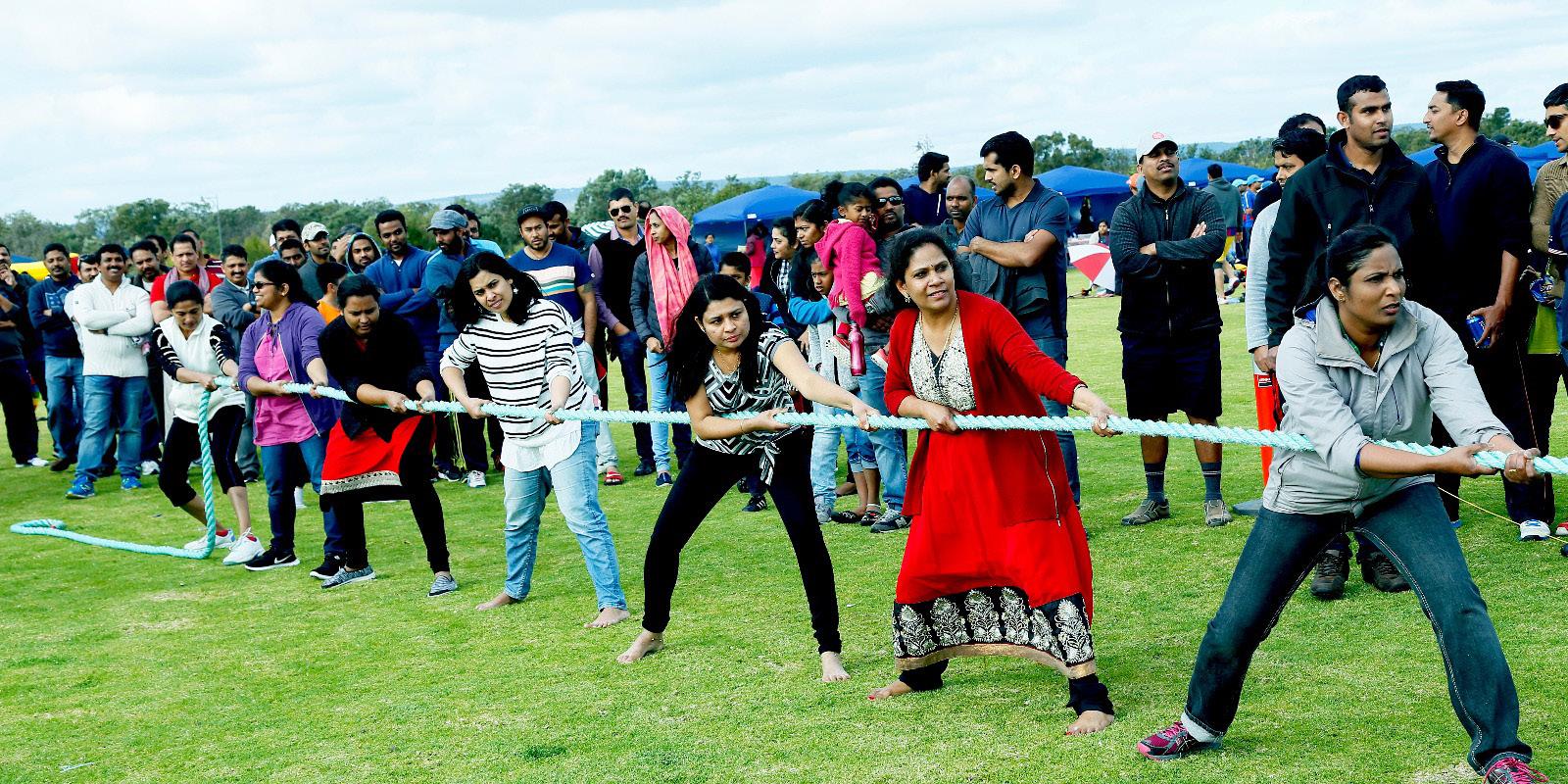
While those gathered at Harrisdale Pavilion had a gala time, the event also had a philanthropic side to it as it raised over $3,000 for Starlite Children’s Foundation that works for seriously ill children.
The event was hosted by Perth United Malayalee Association (PUMA), a nonprofit cultural organisation.
Talking about the event, Thomas Daniel, President of the association, said, “We have always been hearing about God’s own country. We wanted to add an essence of that right here in Perth and show others what it feels like,” he added.
The event kick-started with a bold and rhythmic inaugural group dance. But the crowd puller for the day was the Tug Of War. Four teams competed amidst thumping cheers from a packed audience for the champion’s trophy after what took months of dedicated practice.

Then there was cricket, athletic events and sports for men and women exclusively. Face painting and henna tattoos, pony rides, jumping castles and variety of games added to the gaiety. To sum it up, it was evident that the Malayali diaspora love to celebrate in gusto, wherever in the world they are.
But it was the culinary delights that caught my attention. From the tangy red fish curry topped with turmeric fla oured tapioca to the appam and stew and the traditional hand brewed black coffee, everything was authentic Kerala style.
“Raising funds and mobilising the crowds was the most challenging part, but through multiple forums, digital teaser mails and posters, that was taken care of,” said Amal Raj, the secretary of PUMA. “There are almost 7500 Malayalis living in WA alone and most of them are well connected through Facebook and cultural associations. hat definitely speeded up the branding, marketing and connected us to the right sponsors,” said Sujith Abraham, PUMA treasurer.
or the closing ceremony and final prize distribution, the chief guest was Yaz Mubarakai MLA, Member of Jandakot Australian Labor Party.
Mubarakai expressed astonishment at the felicity with which this event was executed. “This appears to be a perfectly executed management lesson, with all the principles of leadership, team work and time management, harmoniously synced under the same umbrella,” he said.
For some participants, the day turned out to be even more special as they emerged winners of the lucky draw. The prizes included a 55-inch LED TV, iPad and other household utilities.
What made this event distinct from many other cultural programs was that it was all for a cause. Over $3,000 was raised and the amount was donated to Starlite Children’s Foundation. Starlite strives to brighten the lives of seriously ill children and their families. “Through this major contribution, PUMA would be helping many re-discover the joys of childhood,” said a contented Kelly Levender from Starlite.
“This is our adopted home now and we always wanted to give back something to the Australian community,” said Jissmon Jose, the carnival convener.
From very humble origins, PUMA has proved to be a mature and empowering cultural association, keeping up to these ideologies.

India will be the leading source market for tourism in Australia in the next three years, a report by professional ser ices firm eloitte has said.
The report adds that Australia will reach its target of $115 billion in overnight spend by 2020.
A leading source market will be India, with arrivals expected to grow at 12% per year, followed by China and Indonesia , and .
hese figures come rom the assessment of Bryon Merzeo, consultant for Deloitte’s Tourism, Hospitality and Leisure industry group.
It is clear that tourism will remain a high performing sector - along with gas, agribusiness, international education, and wealth management.
This year alone, international arrivals to Oceania (including Australia) have been up in the first our months.
Merzeo notes that, according to a Tourism Australia survey, Australia ranks number one on scenery, sight-seeing, being financially worth tra elling to’, and is an exciting place for conferences.
He says the inbound tourism boom is being egged on by the soft Australian dollar still only valued at around US$0.78 cents.
As well, growth remains strong across many sub sectors of the travel industry, notably into Australia’s state capitals, which are seeing a hotel building boom. These gateway capitals are also enefiting rom more cruise ships arri ing, more direct flights eing added rom o erseas markets, antas will soon fly London to Perth direct), and continued high demand from overseas tourists.
However, there are disparities and growing pains, says Bronwyn White, strategist and co-founder of MyTravelResearch.com. White says she is concerned about inadequate dispersal of tourism dollars beyond Australia’s visitor hot spots.
She believes tourists visiting friends and relatives, especially those from Commonwealth countries such as India, should be encouraged more.
With Tourism Australia no longer
FESTIVAL
Rockstar Dandia by Arvind Vegda
Sat 16 Sept Yuva Gujarat in association with Desi Dreamz presents Dandia Season 2017 Perth at Curtin Stadium, Kent Street, Bentley from 7 pm till late night. Details Raj 0433 698 525, Kunjal Shah 0411 428 860
Indu Patel and Group (Dual Voice Fame)
Sat 23 Sept Dhoom Club in association with Vibrant Gujarat, Toram Finance and Woodvale Tavern presents Navratri dandia 2017 at Curtin Stadium, Kent St, Bentley from 6.30pm onwards. Kids under 10 free. Tickets www.premiertickets.com.au
Navaratri by Malhar
Sun 24 Sept Gujarati Samaj of WA presents Garbha at Willetton Sports and Community Centre, Burrendah Blvd, Willetton from 7pm to 11.45pm. Details Keyur 0412 660 331, Dipon 0434 195 377
Navaratri by Music Mantra
29-30 Sept Gujarati Samaj of WA
presents Garbha at Herb Graham Recreation Centre, 38 Ashbury Cresent, Mirrabooka from 7pm to 11pm. Details Vinod 08 9246 4839, Alka Parikh 0402 389 153
Durga Puja
Sat 30 Sept Probasee Bengali of Perth (Ekottro) announces a multicultural evening at Canning Town Hall from 7pm to 10pm. Details Tani 0424 442 549
Shubo Sharodiya
29 Sept to 1 Oct Bengali Association of Western Australia celebrates Durga puja silver jubilee at Vasto Club, 5 Vasto Place, Balcatta, WA. Details www.bawa. com.au
Punjabi Khed Mela
Sun 24 Sept Bertram Punjabi Club and Loan Market Balpreet Singh presents Punjabi sports and multicultural event at Calista Oval, 2 Walgreen Crescent, Calista from 9 am to 6 pm. Entry is free. Join in for Kabaddi, Volleyball, Bhangra, Solo performances
responsible for promoting Australia to its home market, local authorities and councils have to reach out to domestic and international travellers.
“Many upcountry local authorities and councils need etter financial planning, tourism investment support and marketing guidance to really get their share of the tourism dollar,” says White.
Labour supply and skill levels will also be a challenge. With a hotel construction boom underway – there are over 125 new
properties in the pipeline across the country – MyTravelResearch.com tourism industry members wonder where the workers will come from to sustain the hotel and tourism boom.
er eo notes that ustrade had identified the challenge and has commissioned tourism labour force surveys.
Labour and room supply notwithstanding, Merzeo says, “We are in a fantastic place with a lot of positive growth signs. Everyone seems to love Australia.”
and many more fun attractions. Details Jagga Chauhan 0423 945 915, Sandeep Gill 0450 413 558.
Hindi Divas
Sat 16 Sept Hindi Samaj of Western Australia in support with Consulate General of India, Perth is celebrating Hindi Divas at Manning Centre, 3 Downey drive, Manning from 4pm6pm. Details: Arusha 0405 491 001, Hema 0430 702 209
Punjabi Virsa
Sun 17 Sept Punjabi Virsa Club live in Perth at Curtin Stadium, Bentley at 2pm. Details Manjinder Gill 0452 439 001
Spring Music Fest
Sat 23 Sept SRI and Zstar entertainment present Vijay Prakash (Jai Ho fame), Vandana Srinivasan, Nikhil Mathew and Neha Venugopal live in concert at Kennedy Baptist Auditorium, Farrington Rd, Murdoch from 3.30 pm- 7.30 pm. Details 0410 141 400; 0422 410 381.
STAGE
Satinder Sartaj
Sat 30 Sept Punjab Ventures and Sarpanch group presents The Black Prince concert, Satinder Sartaj Live in concert at Kennedy Baptist College, Farrington Rd, Murdoch. Details Harpreet Singh 0433 307 518, Prabhpreet Singh 0430 581 080.
SEMINAR
Doctors’ annual conference Sat 16 Sept WA Indian Docs proudly presents 2017 annual scienti c meeting and conference at Novotel, Langley, Perth. Details www. indiandoctorswa.org.au
Compiled by Puneet Anand
To have your event listed, email media@indianlink.com.au















TIA SINGH Young Journalist of the Year
Indian Link’s Tia Singh brings home the honours at the NSW Premier’s Multicultural Media Awards 2017


BY
RAJNI
ANAND
LUTHRA


Huge congratulations to Indian Link contributor Tia Singh who took the Young Journalist of the Year honour at the NSW Premier’s Multicultural Media Awards 2017.
Tia received the award from the Minister for Multiculturalism Ray Williams at a ceremony on 30 August.

Tia’s work at Indian Link has straddled many genres: literature, Sikh history, entertainment. Yet, it was her work on gender equality and domestic violence that stood out this past year.


As the community reeled under the shock news of yet another case o horrific domestic a use this time in a high profile ydney amily ia vented her frustration in a piece that was widely read and shared. (‘An open letter to my fellow Indian-Australian youth on violence against women,’ Indian Link August-1 pg 39).
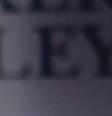




er work reflects the need or di erse voices to be heard in our media landscape, just as much as it does for community youth to tell their stories - whether they are of dancing the bhangra in gay abandon, or angsting about growing up “different”, or even calling out the idiots amongst us who openly treat women as less than equals.
“My connection with Indian Link has reiterated my flair or writing and oice the issues of my demographic,” Tia observed. ia, , egan her association with Indian Link in . er first appearance on our pages, though, was way back in 2010, and on our cover, no less. It is an edition that her mum has preserved carefully, even displaying it at the family home’s formal room. (Tia was one o the high achie ers we profiled that year.)
It is quite clear that family support has been a huge deal for this up and coming youngster.
“I owe a lot to my mum; her belief in me has been unwavering,” she said. “But I dedicate my award to my grandad, my Nanu, who we lost six months ago. As a lover of the arts - he was a poet and a photographer - he encouraged my creative endeavours ever since I was a child, especially to write.
‘‘ ‘‘
(Tia’s) work reflects the need for diverse voices to be heard in our media landscape, just as much as it does for community youth to tell their stories

women like Nikita Chawla, whose husband took a meat cleaver to her head, and Deepshikha Godara, whose intervention order against her estranged husband ran out four days prior to her murder. It starts with one misogynistic joke, one aggressive comment, one remark demeaning women. It is common to joke at the expense of women: we hear it in our songs, we see it in our movies, but just because it is common in our society, it does not make it okay. The Australian government recently launched an anti-domestic violence ad campaign, “Stop it from the Start”. I am all for a bit of banter, but it is On violence against women An open letter to my fellow Indian-Australian youth: When it comes to domestic violence, it should be a deeper conversation than “If he hits me, I’ll just hit him back…” BY TIA SINGHand women in general,” she said. “I wanted to give a voice to trauma.” She went on, “Writing is deeply cathartic. Studies have shown it has the ability to heal physical wounds, so imagine how powerful it is for mental or emotional trauma.” Kaur said that growing up, she was a “fly on the wall,” and posting to social media was a “way of expressing [herself] almost silently.” She claims she accidentally fell in to writing, after reading the works of poets like Khalil Gibran. “I felt seen for the first time, and this was through other people’s words,” she said. It is apparent that the same sensitivity in her own poetry has Photos: Prudence Upton


NATIONAL EDITIONHe kept cutouts of every single article of mine. I wish he was here to see me win the award.”
Congratulating her, CEO Pawan uthra said, “ ia’s knack or finding leads and seeing them through to conclusion is commendable. She has also impressed with her infectious enthusiasm, goodnatured vivacity and ready smile.
I congratulate her on behalf of the Indian Link family and wish her
enabled it to resonate with so many people. Having been told that there was no space for her and her writing in the Canadian literary sphere, youth
be considered ‘taboo’ subjects such as menstruation, abuse, and sex, as well as love, loss and survival. our backs tell stories no books have the spine to carry “I wanted to give a voice to women’s experience, not just my own, but my lineage, ‘‘ ‘‘Kaur was articulate and spoke confidently, warmly and openly answering questions posed by host Sara Mansour, and reading to the audience from her bestselling book. Towards the end of the “In-Conversation” session, Kaur laughingly told her fans that “this is the most I’ve shared in an interview!” An acclaimed poet, 24-year-old Kaur initially appealed to Generation Y as an ‘Insta-poet.’ She took to social media platform Instagram to post her photography and her poetry about issues that she felt passionately about – a step that has now amassed to a 1.3 million strong following. Writing about women’s experience, Kaur taps into what mayall the best.”
‘My heart aches for sisters…’ so Rupi Kaur writes for their pain BY TIA SINGH I didn’t do it in the traditional way… I didn’t smash the gate, I just created a whole di erent gateKaur decided to self- publishing in 2014. “I never paid any mind to those who said I did not fit the mould. I didn’t do it in the traditional way… I didn’t smash the gate, I just created a whole different gate,” she told her smitten fans. Milk and Honey was later rereleased by Andrews McMeel Publishing, and it became New York Times bestseller. Kaur moved to Canada with her family at age 5. Unable to speak English at the time, she began to paint. An ode to her humble beginnings, all the illustrations in Milk and Honey are Kaur’s own. Kaur is currently editing her second book and touring the world, speaking about her journey and meeting fans She credits her success to her dedication to the art, and the unaffectedness in her work. “I wasn’t born a great poet,” she said. “It took discipline and hard work.”Discovering her selves Breaking barriers, one poem at a time In a sold-out session, new age poet Rupi Kaur sat down in front of an audience of over 200 as part of the Sydney Writers’ Festival, to talk about her work and her journey. Kaur is a Canadian- Indian poet, spoken-word artist and visual artist, whose collection of poetry Milk and Honey has sold over 1.4 million copies worldwide. Half expecting to see a room full of young Indian women, it was refreshing and inspiring to see the auditorium brimming with young women - and men - of all cultures, clutching their copies of Milk and Honey. It is a testament to her role in inspiring the younger generation to fall back in love with poetry.concerning how the jokes regarding violence against women come so naturally. It has happened with me: sitting in a group of friends, banter flying here and there, when in response to a joke I made, a generally warm-hearted male friend retorted Mein jooti laava?” (“Should I take off my shoe?”) Do we really find jokes that demean one sex to elevate another, funny? We seem convinced that domestic violence cannot and will not happen to us or our peers. We are educated, we are independent, we live in a civilised society. However, the ying nd nitely an uence JUNEAt Indian Link, we are proud to be able to provide a platform for emerging talent. This latest award marks our third for young ournalists, ollowing itam itra and Namita Gohil (2016).
It also boosts our reputation of being Australia’s most awarded multicultural media group, taking the group’s tally of media awards to 21.

Their commitment to the permanence of their love affair began with a visit to a store borne out of the passion of a metalsmith and sculptor – you might have heard of Georg Jensen.
On the 8th day of the 8th month of the year 2008, amid the sparkles and lustre of art inspired elegance, Sam and Zlatko chose their engagement rings together as a symbol of their serene and spirited love while the streets of Melbourne buzzed beyond.
BY ANEETA MENONAustralia. Since then, the matter of whether the law should be reverted to its initial state has been hotly debated.
we, as a community, usually celebrate with reckless abandon.
“Who loves and values weddings (and, along with it, marriage) more than our community?” asks Kharishma D’Souza, a corporate banking professional and mother who recently represented Indians on a marriage equality panel in Sydney.
From 12 September, the Australian Bureau of Statistics will be mailing out the Australian Marriage Law survey - a postal poll commissioned by the federal government to gauge levels of support amongst Australians regarding a change to the Marriage Act. The survey is not compulsory, and is not a formal vote to change law. The question will read “Should the law be changed to allow same-sex couples to marry?” and the options to respond will be a simple Yes or No. After its introduction in 1961, the Marriage Act been changed twice. Initially, the legal marrying age was 16 for females and 18 for males. This was amended in 1991 to equalise the Act, making the legal marrying age or all people. rior to , there was no specification in the arriage Act regarding the gender of those seeking to wed. Under the Howard government, the Act was amended without consultation of the electorate to specifically prohi it same sex couples to be recognised as married in
The issue has been as divisive as it has been prolonged, despite routine polling showing that the majority of Australians now support the change. Core opposition to marriage equality comes from socially conservative religious groups, who claim the changes to civil law will impede their religious freedoms. As evidenced by the precedent set by over 22 other nations over the last 17 years, this is simply not the case. Religious organisations will remain free to conduct their ceremonies in line with their beliefs.
other minorities the same access to live equally. Despite many claims otherwise, same-sex and de-facto couples in Australia do not already have the same civil rights as married couples. A crucial area in which there is inequality is surrounding the death rites and enefits o partners, including eing listed on the eath ertificate as next of kin.

Some time later, by chance, and perhaps by some providence of Paramatma, a faulty watch led Sam on a quest to find his right time. From his many broadcasts for assistance, it was the reply from Georg Jensen’s homeland which helped Sam to recover the perfect function of his timepiece.
In most sub-continental cultures, death rites are one of the most important parts of existence, and a situation where a spouse can be denied input over what happens is unthinkable. This is just one of the many ways amending this law will directly impact people.
Sam & Zlatko’s Surprise Wedding
When talking to immigrants, particularly those from the sub-continental community, about why they’ve chosen to live in Australia and what they love about it, the answer is almost always freedom. Australia permits our subcontinental community the right to practice our beliefs and embrace our culture free of persecution or discrimination.
s we en oy the enefits o tolerance and acceptance of the greater Australian community, it would be wrong to deny
Whilst the proportion of same-sex couples is comparatively low in subcontinental communities, it is not nonexistent. When I approached a gay friend in a committed-long term relationship to contribute their views for this article, I was met with apologies, and the heartbreaking explanation that “Only a select bunch of Indians know, so that Mum doesn’t get dragged through the mud. Especially while my Nana is alive.” So, whilst we’re usually talking about the community at large, it is important to remember that we must also consider those in our communities who face discrimination, shame and, above all, fear. Not just for themselves, but for their loved ones, about an area of their lives that

Growing up in Malaysia, it wasn’t until Kharishma moved to Australia that she was able to see the possibility of true equality. “I had plenty of people in my own circles who were discriminated against, but in Australia people are quite accepting. Being different was celebrated.”
The panel, attended by representatives of the multicultural community, was positive and many of the questions were answered. When asked why Kharishma was passionate about this, she said that it was important for her to be part of the way forward for her children and the next generation. “It is our turn to do this. We all love living in Australia, and this (freedom) is why.”
The Asian Australian Alliance, a group that represents the interests of Asian communities in Australia, agrees with Kharishma.
Speaking on the matter, Molina Swarup Asthana, convenor of the Asian Australian Alliance, has said, “LGBTI Asian Australians are being treated as
To ensure that our families and communities are safe, embraced and respected, we must ensure that all the other communities in Australia are safe, embraced and respected, tooMelbourne-based Indian academic and Odissi exponent Dr Sam Goraya wed his partner, creative artist Zlatko Varenina, in Copenhagen in 2014
second-class citizens as they are currently being discriminated under the law and are being excluded from the civil institution of marriage, which is a right that must be available to all Australians.” Concurring with other community view, she concluded, “To be able to marry and form a family is a basic human right.”
Over time, much of sub-continental culture (both in India and abroad) has been hi acked to ser e personal interest, profit and patriarchy. Therefore, the personal discomfort felt by some of our community by concepts such as marriage equality are understandable. Hesitation, fear and prejudice are due to the multigenerational conservatism entrenched in global Indian culture.

Speaking from the community itself, Kunal Mirchandani of the South Asian LGBT support group Trikone, urged those sitting on the fence to consider the ramifications o their am i alence. “We’ve all been here before,” he says, and explains, “There was a time not long ago when Hindus couldn’t marry Muslims, or widows were forbidden from remarrying. e ha e changed the definition o marriage time and again, and the world didn’t end. ery generation gets to define its own values. And this is your chance to make a difference. Be an agent of change. Challenge the status quo, and let’s make history happen.”

However, looking back at ancient India, and specifically induism, pairings such as these were commonplace. This is to be expected as the Hindu philosophy, at its core, focusses on the journeys of the noncorporeal, genderless soul throughout many incarnations until moksha, or liberation.
gets taught in the classroom, and updating the Marriage Act will not change that.
No changes will be made to how couples conceive or adopt children, regardless of the outcome of this survey This is just about whether couples should be allowed to marry.
Marriage matters to Australian society and it matters to many couples. Changing the law will ensure equal rights under the law to all married couples, regardless of gender.


Marriage equality was first legalised in the Netherlands in the year 2000!
UK, USA, Canada and New Zealand – countries with the largest sub-continental populations (aside from Australia) have all had marriage equality for years!
Over 22 countries, including almost all developed nations, have equal rights for married couples. They are:
Argentina (2010) | Denmark (2012) | Greenland (2015) | The Netherlands (2000) | South Africa (2006) | Belgium (2003) | England / Wales (2013) | Iceland (2010) | New Zealand (2013) | Spain (2005) | Brazil (2013) | Finland (2015) | Ireland (2015) | Norway (2008) | Sweden (2009) | Canada (2005) | France (2013) | Luxembourg (2014) | Portugal (2010) | United States (2015) | Colombia (2016) | Germany (2017) | Malta (2017) | Scotland (2014) | Uruguay (2013)
Source: http://www.equalitycampaign.org.au
Hindu pundit Rami Sivan states, “The Australian Council of Hindu Clergy gives its un ualified support or e uality o all citizens before the law and supports the right of everyone to live and love in dignity, peace and security.”
While the Judeo-Christian faiths have mixed feelings on the topic, there are many proponents of marriage equality. “It
is in the spirit of Jesus that we say yes to marriage,” Reverend Dr Keith Mascord said at a Christians for Marriage Equality press conference. “It is not in spite of our faith, but because of our faith that we say yes to marriage equality.” At the time of writing, a Facebook page called “Muslims for Marriage Equality” had over 1,300 followers.
There are many cultural rites practiced by our diaspora that the greater Australian community finds con ronting or uncomfortable. Whether it is the ritual shaving of a baby’s head, the painful piercing of a small child’s ears or the circumcision of male infants practiced in some communities, the fact remains that we live in a secular democracy.
The discomfort of some doesn’t make it banned for the rest, and this is no different. This is what it means to live freely, multiculturally and respectfully. To ensure that we, our families and communities are safe, embraced and respected, all we must do is act to ensure that all the other communities in Australia are safe, embraced and respected.
There are many things in this world, particularly in these rapidly-changing times, that are confronting and morally challenging. Luckily, equality is not one of them.
Because we should all be equal in the eyes of the law. As a lawyer, I see rsthand how laws are used to divide and demonise communities. How legislation can create an unequal society that prevents people from being treated fairly.
Because when you suffer, I suffer. As a minority in Australia, I know what it is to be told “You don’t belong here”, through the way laws are upheld, through the treatment I receive from strangers, through what the media says. We are all in this together. We know the sting of being an outsider. Nothing will change unless we stand up for others.
Because, 50 years ago, I wouldn’t have been able to enter this country because of the colour of my skin.
Because nothing will change for me. The sun will still rise in the east and set in the west. I will wake up, take the train, go to my job in the city. I will still pay my taxes and save for my next holiday. I will still be married to my husband. A man who, not that long ago, it would have been illegal for me to marry because of the difference of our skin colours.
Because everything will change for the people I love. My friends will be able to love freely and openly. They will know that the majority of this country backs them, supports them for simply being who they are, for loving who they love. They will be able to have a big lavish wedding and wear that big white dress or a sparkling red sari. They will be able to have a small intimate affair surrounded by the people most important to them. They will be given a choice.
They will have the choice, like I did, to declare publicly that they found the person they want to spend the rest of their life with and have Australia recognise that as fact.
Because we won’t be separate anymore.
Because we should all be equal.
Sharika JeyakumarThe Australian Council of Hindu Clergy… supports the right of everyone to live and love in dignity, peace and security Hindu pundit Rami Sivan
Kashif Harrison (KH): Alan, welcome to Indian Link Radio. You’re originally from Delhi, you’re a dad of two kids, and you’re from Trikone Australasia.
Alan Maurice (AM): I am. Trikone is a social support network for South Asian gays, lesbians, bisexuals. I came to Australia in 1977, as an 18-year-old. I lived with my mum here. She arranged for me to meet with a ortuguese girl one day. I figured later that it was probably just as good as any Indian arranged marriage (laughs). We met, and within a year I realised I had some feelings for her; I didn’t start with any feelings for her, so I thought this Indian idea of arranged marriage must be real because obviously you don’t all in lo e at first sight, there’s no such thing. We got married a year and a half later. I was . e had our first son when I was 28. Today, he is 31. Our second son came along in 1992, and at the same time as that happened, these (other) feelings started to get much stronger in me. Even though I was really happy for 10 years in my marriage and life was great - we had great social life etc - I think I was trying to hide something. We went out a lot; I dragged her to every Indian mo ie I could find ecause she’s not Indian met with family, went out dancing and clubbing with friends. When our second son came, there was this explosion of emotion and at the same time I met somebody in my workplace, an English guy I felt completely in love with. I had no idea what was going on actually. I then started to realise ‘Achcha, so this is love, this is what it means’. Well not so much ‘this is love’, but more like ‘this is love at first sight’.

My challenge was, I was still in love with my wife; in fact, I still am. It was a very dark period for me and it was very hard for her - but I knew I had to move out of the marriage. My boys were very young at the time, aged four and one. I lived together with my new partner for 16 years.
During that time I was very connected to my wife and my sons. I would go twice a week and spend time with them, sing them lullabies at night, make up stories to tell them at edtime. ut it was a ery di ficult time. I think they were too young to realise the detail, but it’s hard enough when a marriage reaks up, and it’s definitely hard on children. I know this from my own experience when my parents broke up.
So what she and I did was, we put our children first and we tried e erything possible to make sure their lives were balanced - I hate using the word ‘normal’. Skyway through many years, today we have a very good relationship. In fact my ex-wife and I only became ‘ex’ about three years ago - we were still married for all those years. We just didn’t see the need to get a divorce, I think we both felt that it was a clear-cut arrangement.
So anyway, we still have a good relationship. My sons and I are good too; my older son did go through some di ficult times that was
more to do with the break-up of his parents than anything else) He’s a very strong guy; emotionally he’s a bit charged up so I wasn’t sure how to deal with it. ut o er the last fi e years we have a very good relationship and we’re in business together. One son’s a builder and the other’s an electrician, and I manage their books for them.
KH: You don’t look like a father of two boys aged 25 and 31! So here’s the thing Alan, one of the issues in the ongoing debate about marriage equality, is that same-sex relationships are not good for kids. The perception is that parenting styles are not healthy, and that the kids face physical and mental health issues. But you seem like a wonderful family man: what was it like raising two kids that you seem really proud of?
AM: ook, it’s definitely not easy, I wouldn’t rush out and say, go have children. But to me it makes no difference if you are gay parents or straight parents. If you’re going to have unhealthy children, it’s going to happen, more out of bad habits and not looking after them and watching over them, than anything else. You only have to look across the whole spectrum of families to see how much dysfunction there is anyway. So from that point of view, we are really blessed. But, sure, we did have problems. Going to soccer matches, or parent-teacher meetings, it was always di ficult, ecause in aria ly, someone was looking and saying ‘Where’s their mother?’ or when she went, ‘Where’s the father?’. Even at that level, there is a taboo, as to why the parents aren’t together. n the soccer field, guys might make jokes about gays… and you have to watch your son try to process this horrible experience, of someone saying something knowing his dad is standing right there. And you think, do I say something? How do I support them? It’s a really tough time. And they went through some really tough times. One day my younger son and I were walking down the street in Newtown where I live and these young guys drove by and screamed out some homophobic abuse. My son, 13 , was in complete shock. He couldn’t believe it. But it actually made him stronger in his desire to defend people like myself right across. Now, he’s got a strong sense of social justice from things like this.
KH: At 25 and 31, your boys must be looking at relationships themselves. How are you going to deal with that - if their family is not open to the idea of same-sex marriage or same-sex parents?
Have you thought about that?
AM: Think about it all the time. In fact, e en when they meet a girl or the first time, our first reaction is oh god, now we have to come out again’ in some shape or form. But the blessing is that both my sons are completely okay with it. So when they meet girls, they are really upfront about the
situation - my dad is gay; he’s got a partner, blah blah blah. If you’ve got a problem, speak now. And if it’s a problem it probably ends what was a short-term relationship. I don’t know, they’ve never said it has caused a problem, they are totally cool.
KH: Have your boys been to India?
AM: I took them to India or the first time in 2015. They don’t speak any Hindi. I have a pretty good relationship with a bunch of guys and girls from school, you know - the typical WhatsApp group and that kind of thing. And I am pretty open on Facebook. While friends and family are completely okay with everything, nobody talks about it. I think we discussed it once in one or two sentences, and then it was like ‘Chalo, khao piyo (let’s eat), let’s have a good time’. So that’s about it. They know my sons are quite cool about it, they were quite loving to my sons and made them feel at home. So it was really interesting.
KH: What about the young generation in India?
AM: No in fact, most of the younger generation don’t have any issues.
KH: In the current debate on the issue though, it is said that the Indian community here will probably not accept same-sex relationships.
AM: Yes it’s really interesting, and it happens across most cultures. There is more exposure in India, than there is the Indian community here in Australia. I think it is mostly because when you are a migrant in a new country you kind of lock yourself into the Aradhana class of songs (that you just played!) rather than realise that it is 2017 and maybe there is a new song that is out. So maybe the mentality and everything else is still locked into the Indian you were when you left, or when your parents left and came here. And it is usually the parents that are forcing this mindset.
I stay tuned into Indian news. There’s a lot of stuff happening in big cities. They are having Pride Marches all over the place, which takes a lot of courage because legally, it’s still an issue over there. Some people are really open about it, they are out and proud; and some others are struggling and finding it really di ficult. amily pressure is still a huge thing. They obviously don’t want their children to be gay. They want them to marry
and some parents will say ‘we don’t care if you are gay, you must get married anyway’.
KH: Obviously you’ve been through a lot, but you’re definitely standing up for what you believe in - you’re teaching that to your kids as well. Now, let’s talk a bit about the same-sex marriage postal vote.
AM: To clarify, the actual vote is not going to be due until early November. For me personally, I’m going to be 60 next year. So for me, the marriage thing is not so important. I have had a marriage, I have had a long term relationship and my whole thinking about relationships is different. So I’m not going to rush to bring out the shervani… Marriage equality for me is about equality. It’s about (the fact that) you and I are human beings, we are both equal, we have the same feelings, we have the same emotions, we are the same. And so, what equality does is, it simply raises the bar yet again to say ‘these people are normal’. Which everybody thinks is not the case. We are exactly the same, and by changing it in the law, it gradually changes it in society. And that takes the pressure off children who are being constantly told that there is something wrong with you, or something wrong with your dad. So from a generational point of view, it’s very important that children are made to feel that it’s okay. We have enough negativity around in the world today, enough really bad stuff happening, to not allow children to grow up in a healthy, loving atmosphere.
KH: What are your plans for Father’s Day, Alan?
AM: My sons have invited me and my partner to my mother’s place, where she is going to cook an Indian meal. Both my sons love Indian food. The extended family catches up once a month, there’s about 1517 of us. But tomorrow is just for me for Father’s Day, and my sons.
KH: Happy Father’s Day to you. I’m so glad to have had you in the studio to tell us about your journey. You’re celebrating Father’s Day the same as the rest of us. It doesn’t matter what your sexuality is, you’re living the same normal life like everyone else.
AM: (Laughs) I’m living the same boring life as everyone else!
KASHIF HARRISON speaks with Alan Maurice on what it means to be a gay dad

Australian basketball fans are set to cheer on a former Indian captain as well as Team India’s current skipper, after a pair of historic signings by NBL clubs Adelaide 36ers and Sydney Kings. While the 36ers have, in conjunction with the Dream Basketball Academy, signed former Indian captain Vishesh Bhriguvanshi on a one-year training contract, Indian skipper Amritpal Singh has been selected as a member of the 11-man Sydney Kings squad, after his impressive recent outing with the Sydney Kings Invitational Team in China. The duo are the first Indian players e er signed y an ustralian asket all outfit, orming part of a move by both clubs to build up their respective fan bases in the Indian community, both domestically and abroad. Indian Link recently caught up with Vishesh and Amritpal to hear their thoughts ahead of a historic summer of basketball.

Standing at 7’0” and 116 kilograms, it’s easy to assume that Singh was born to play basketball; but it’s a relatively new foray for the 26 year-old, whose humble beginnings cast his meteoric rise in even more an astonishing light. Born to a family of humble vegetable farmers, Singh grew up helping his ather plough rice fields in Ganna Pind, a small rural village in Punjab with just over 2000 inhabitants.
More than 10 km away from the nearest train station, Singh - a kabaddi player who didn’t know what basketball was until the age of 18 - seemed destined to follow in his father’s agricultural footsteps. But after being introduced to basketball by his uncle in 2009, the towering center found himself representing India at the Asian basketball championships just two years later at the age o , and is now one o the most prolific and dangerous basketballers in the region.
Sydney Kings Head Coach, and Australian basketball legend Andrew Gaze, spoke glowingly of Singh’s pedigree.
“Amritpal was a very strong contributor to the Kings off-season program, particularly during our invitational tour to China,” said Gaze. “His rebounding was a major factor that allowed us to win the Suzhou event, and he also picked up our overall playing
philosophies and schemes quite quickly,” Gaze said.
Amritpal himself was modest. “Playing with the Sydney Kings, my game will improve more,” he said. “I’m very excited because it’s a big opportunity for me and a lot of Indian basketball players are looking up to me. I want to do my est in my first season with the Kings and I hope the Indians will support me and the team”.
One man who knows Singh better than most is his India teammate, Vishesh Bhriguvanshi. “It’s a big thing that (Singh) got selected for the Kings,” says Bhriguvanshi. “He performed very well in the China invitational tournament. He’s a nice guy and a good player. He’s one of the big 3 in the Indian national team, and it’s definitely great that he’ll play in ustralia he’ll learn so many things and he’ll help the national team more.” It’s a sentiment Singh reciprocates, noting fondly the time he and Bhriguvanshi have spent playing together in the domestic club scene.
Bhriguvanshi’s journey to the top is no less remarkable: at a relatively slight (by asket all’s standards ’ , the year old shooting guard rom aranasi first started playing basketball with his elder brother at the age of 12. Within a year, he was
representing his district and state; by 17, he was already a member of the national side; and by 19, Bhriguvanshi was named captain of the Indian team. Having been born to a lecturer and a school principal, Bhriguvanshi’s future, like Singh’s, could easily have been vastly different if not for a few quirks of fate.

Bhriguvanshi was initially introduced to the 36ers by the Dream Basketball Academy, which is designed to allow young, elite basketballers to transition from high school to the NBL and ultimately to the NBA, under the guidance of some of the best coaches and trainers in the business, including Dream Academy managing director and co-founder Raheim Brown, a former professional basketballer with experience in several premier basketball leagues around the world. Brown’s biggest success story with the Dream Academy to date is the development of US sensation Terrance Ferguson, who in 2016 skipped the traditional college pathway to the NBA, instead opting to spend a year with the Dream Academy and the 36ers, before being picked up by the Oklahoma Thunder in the 2017 NBA draft.
Speaking about his journey to Australia and his upcoming time at the Dream
Academy, Bhriguvanshi is not short of excitement. “The NBL is one of the world’s biggest leagues after the NBA,” he said. “Every player has a dream to play for a reputed league some day, and so it was my dream. Representing the nation is very di erent eeling, and I am definitely proud of that, but playing in a league like this has always been my dream and that is what keeps me motivated.”
“It means a lot because I’ll come to learn so many new things and Raheim will train me,” he added. “It’s a really big thing for me and it was very big news (in India). I was like, eally ’, and aheim said, efinitely, we’ll train you the same way we trained Terrance and try to get you in the NBA’. I’ll try to give it my 100% - every basketball player’s dream is to play in the NBA, and especially coming from a country like India, it’s a very big dream for me.”
Both the 36ers and the Kings are intent on growing the fledgling relationship between their clubs and fans within the Indian community. Sydney Kings Managing Director Jeff Van Groningen noted the significance o ingh’s signing, saying “ e take our responsibility as a member of the global basketball community very seriously and endorse the NBL’s focus on ‘bridgebuilding’ with those that share an interest and passion for our great game both in India and within the Indian community here in Australia. We are excited at what Amritpal can contribute to the Kings as a strong, rebounding big man and we look forward to contributing to his rising career.”



The Dream Academy, meanwhile, is also excited to share Australian and Indian cultures with Bhriguvanshi, noting its ultimate goal of putting Bhriguvanshi through a workout in front of NBA teams or the NBA development league. “With his competitive spirit and style of play on the court and his humble but strong personality off the court, he is a great addition for us,” Brown said. “We look forward to this new relationship, not only with Vishesh, but with the whole of India. He will represent the Dream Academy and the Adelaide 36ers proudly for his country and himself.”

Representing the nation is a very di erent feeling, and I am proud of that, but playing in a league like this has always been my dream
Vishesh Bhriguvanshi(Facing page) Basketball great Andrew Gaze welcomes Amritpal Singh to the Sydney Kings. (Left) Vishesh Bhriguvanshi of the Adelaide 36ers. (Bottom) Amritpal Singh in action
 BY APARNA ANANTHUNI
BY APARNA ANANTHUNI
Don’t touch my body in the road, Shyam.
Lover, let me go fetch water. My mother-in-law and sister-in-law will hear of this; why do you frighten my heart?
One thing is that you have taken my company; the other that you keep touching me. The water-pot on my head shakes.
Why do you take my hand?
(Translated by Lalita du Perron, Hindi Poetry in a Musical Genre: Thumri Lyrics)
This is an example of thumri, a genre of North Indian musical poetry. The speaker is a woman fetching water. Her addressee is, of course, Shyam, ‘the dark one’, a wellknown epithet of the god Krishna.
If you were to delete the reference to ‘Shyam’, however, these lyrics could be viewed in a far less than charming light.
The woman’s body is being touched, and her hand taken, even as she asks the man to stop, to leave her alone. She is frightened and defenceless.
Delete the references to divinity, and she is being sexually harassed.
In her recent seminar at Monash University’s Sir Zelman Cowen School of Music, Dr Lalita Du Perron, Associate Director of the Centre for South Asia at the University of Wisconsin-Madison,


explored the connections between the colonial sanitisation of the thumri genre, Krishna mythology and ‘eve-teasing’ - the harassment of women by men in public spaces - in North India.
Du Perron described thumri as “the quintessential courtesan song,” which changed from a danced to a solely vocal genre during the nationalist movement in colonial India, and was “desexualised” and “devotionalised” in the process.
“
Tawaifs - public women singing about harassment in public spaces - were replaced by middle class non-hereditary and thus non-public singers, describing their own private relationship with the god Krishna, no longer molester and always divine.”
Du Perron pointed out that, while eveteasing is condemned as unacceptable today, sexual harassment remains “incredibly common in orth India, her field o enquiry.
“So how is something that everyone considers unacceptable acceptable?”
She argued that “the archetype of the infantalised divine prankster - the god Krishna - whose amorous overtures are always secretly pleasing to the female recipient, has created a discursive space in which no really never means no…”
As she pointed out, ‘man-made notions’ of harassment “do not extend to divine players such as Krishna.” In the realm of this god, harassment is a part of his divine love play.
As an illustration of this blind spot, she turned to the ‘Anti-Romeo Squads’ set up earlier this year by Yogi Adityanath, Chief Minister of Uttar Pradesh (which happens
to be Krishna’s birthplace). Among criticism of the squads was a tweet by senior lawyer Prashant Bhushan:
Romeo loved just one lady, while Krishna was a legendary eve teaser. Would Adityanath have the guts to call his vigilantes anti-Krishna squads?
Bhushan later retracted the tweet, amid death threats and the outcries of outraged Krishna devotees, for being “inappropriately phrased” and apologised for any offence he may have caused.
“In my view, it is exactly this denial of the licence bestowed on sexual harassment by the stories and songs from the Krishna tradition that makes sexual harassment in North India so complicated,” said Du Perron. “The pro-Romeo Squad voices are clearly unwilling to recognise that Bhushan may have had a point. The presence of Krishna, a divine childish quintessential ‘naughty boy’…precludes any real discussion of the problem.”
Dr Du Perron also spoke with candour
about the term ‘sexual harassment’, which, she acknowledged, could be seen as “a Western, white, Anglo-Saxon term.” She described how, when speaking on the same subject three years ago at Benares Hindu University, she was surprised and disconcerted to find that it was young women students who “were up in arms” about her take on Krishna and coercion.
“I don’t want to hurt anyone…(but) this needs to be said,” she added.
The experience has, however, had her think o trying to find “a di erent way into the subject. She is now working on a sister paper to this one, which examines the question of whether sexual harassment is in fact “a white feminist concept.”
You can understand why young modern Indian women, from a relatively progressive university, might still see red at white feminist criticism of Krishna: after all, women of colour have to constantly deal with the “white saviour” mentality around their agencies and empowerment.
But, as Du Perron said, her perspective is made possible by the thumri texts themselves:
Kanha, I am fed up with you, let go of my sari.
Listen, sir, Bihari, I will abuse you.
Night and day he harasses me, he won’t let me go on the road to the water-well, friend Let go sir, let go, sir, don’t lift up the cloth of my veil ‘Binda’, listen, he doesn’t care, and all the women watch.
It is exactly this denial of the licence bestowed on sexual harassment by the stories and songs from the Krishna tradition that makes sexual harassment in North India so complicated
Dr Lalita Du Perron

Following a huge outcry in the Indian-Australian community over the controversial depiction of Kashmir in an SBS video about the Partition of India, the national public television network has uietly modified the map.


While the earlier map showed the entire Jammu and Kashmir state as disputed territory - which had raised the hackles of several Indians the modified ersion o the video clearly shows Indianadministered Kashmir, Pakistaniadministered Kashmir on the state’s western edge and the Chinese-administered Aksai Chin region on the state’s north-east tip.
Indian Link had, in its Sydney edition for the second fortnight of August and Melbourne edition for September, carried a cover story on the community’s outrage after SBS broadcast the map. The story had also reported on the strong action taken by the
Indian government authorities in Australia on the episode.
India’s High Commissioner to Australia, Ajay M Gondane, had issued an ‘oral demarche’ to the Australian government on the subject. India’s Consul General in Sydney, B Vanlalvawna, had also written to SBS, conveying its ‘strong objection to this wrong depiction,’ and provided it with the approved political map of India.
Some Indian-Australians had also approached their respective public representatives over the issue, prompting Michelle Rowland, Member for Greenway, to write a letter to Michael Ebeid, CEO and MD and SBS on the subject.
Balesh Dhankhar, a Sydneybased Indian, had also launched an online petition, addressed to the Minister for Communications itch ifield, on change.org. It had received over 5,300 supporters in a little over a fortnight.

SBS had earlier issued a media release, strongly denying the allegation made in the online petition that SBS was ‘anti-Indian.’
Referring to the change in the graphic, an SBS spokesperson said, “To assist our audiences to better understand administrative arrangements in the Kashmir region, SBS has made some enhancements to the map in the story on the SBS World News ace ook page or clarification.
“SBS is always mindful of community sensitivities when reporting on global issues and tensions such as this and ensures it remains impartial and balanced in its reporting. SBS has long been a supporter of the Indian community as it is to all the communities we serve.”
It remains to be seen whether the modified ersion o the map mollifies the outraged mem ers o the Indian community.

 Harshad Pandharipande
Harshad Pandharipande
Never married 1971-born (looks younger) Hindu Punjabi Brahmin, 5’4”, slim, vegetarian, family-oriented beautiful girl, currently visiting Sydney. Looking for well settled Australian Hindu match. Siblings are Australian citizens. Respond with photo and details on WhatsApp +61-412 733 796 or email at sheelam_pandit@yahoo.com.
Seeking suitable match for Australian citizen. Sydney-based, Sikh girl, 1991 born, 170cm, quali ed chartered accountant, working for Australia’s leading bank. Parents highly educated and well settled in Sydney. Please respond to hs52216a@gmail.com

Seeking a professionally quali ed, settled match for Sydney-based, never married Australian citizen. Hindu, Punjabi Khatri 44, 5’3” slim, fair, attractive girl. Postgraduate and working on a good position in government organisation. Please send details with photo indsyd2016@gmail.com

Seeking professional match for Australian born and brought up Hindu girl. Sociable and friendly, graphic designer, 26 years old, 5’7”. Family-well settled in Australia for 27 years. Please send details with photo to matrimonialaustralia2017@gmail.com

Looking for a suitable girl for a 25-year-old Gill Jatt Sikh boy living in Sydney. He has done B Com Professional from India and is currently pursuing MBA and MPA. Businessman father and homemaker mother, one sister married and living in Australia. The girl should be Australian PR or citizen only and preferably from Jatt Sikh family. Contact +919872037378, +919814037278, 0422183789

A well-settled, clean-shaven 48-year-old (looks only 35) good looking, tall, slim senior manager with one of the four major Australian banks from a Jat Sikh family is seeking a lady with a view to marriage. Citizen of Australia and USA, good natured, sociable with a blend of both Eastern and Western values. Caste and age no bar. Respond to seekerusa@mail.com


































INDIAN LINK RADIO LISTENERS GET A CHANCE TO MEET THE REAL PEOPLE BEHIND THOSE RADIO PERSONAS



























Melbourne listeners Navdeep, Akki and Gaurav are happy to meet with Sagar Mehrotra (extreme left) and Neelam Vasudevan



By replacing and upgrading parts of the existing phone and internet network, nbn is bringing more Australians access to fast and reliable broadband services.*


As most existing landline phone and internet services will be disconnected, it’s important you switch a ected services before your disconnection date.^ nbn will notify you by mail once you can switch to a new plan over the nbn™ access network. You’ll then have up to 18 months before existing services are disconnected.^











This means nbn does not sell to the public. nbn supplies phone and internet providers with wholesale services they combine with their own network services to deliver your new plan. So you’ll need to contact your preferred provider once you’re ready to switch.

You have a choice of speeds nbn o ers three superfast wholesale speed tiers to providers - 25Mbps, 50Mbps and 100Mbps.* There’s also 12Mbps, which is not considered superfast broadband.* Talk to your phone and internet provider about speed tiers available in your area, as well as the actual speeds you can expect to experience on your new plan (particularly during peak times like the evening).



The nbn™ access network and your provider’s network are likely to slow down when more people are online at once. Maximum speeds will also vary based on your modem, Wi-Fi

and other issues.*For more information on how your particular experience will be a ected, speak to your provider.
Important information on device compatibility
Safety-critical devices like medical alarms, fire alarms, monitored security alarms and lift emergency phones, may not be compatible with your new plan at all times.† To help minimise a loss in your services, check with your device provider that these will work on your new plan or whether you’ll need to find an alternative solution. It’s also important you register safety-critical devices with nbn by calling 1800 227 300 or visiting nbn.com.au/compatibility.











*Your experience, including the speeds actually achieved over the nbn™ broadband access network, depends on the technology over which services are delivered to your premises and some factors outside our control (like your equipment quality, software, signal quality, broadband plan and how your service provider designs its network). nbn is a provider of wholesale speeds to internet providers. nbn™ wholesale speed tiers available to your phone and internet provider vary depending on the access technology in your area. ^ Services o ered to phone and internet providers over the nbn™ broadband access network will be replacing phone and internet services provided over most of the existing landline networks, including copper and the majority of HFC networks within the fixed line footprint. Services provided over existing fibre networks (including in-building, health and education networks) and some special and business services may not be a ected. To find out if your services will be a ected, please contact your current phone or internet provider. For more information, visit nbn.com.au/ switcho or call 1800 687 626.† The rollout of the nbn™ broadband access network will involve new technologies, and some existing devices (including many medical alarms, autodiallers and emergency call buttons) may not be compatible with these at all times. You should contact your device provider to find out if your alarm or other device will work when connected to the nbn™ broadband access network and what alternative solutions are available. For more information, visit nbn.com.au/compatibility.

























































and seasonal ingredients in your shopping bag, even the simplest recipes can turn out to be a dream for the tastebuds.

 BY DHANYA SAMUEL
BY DHANYA SAMUEL

We are blessed when it comes to the availability of fresh produce in Australia.






A visit to your local farmer’s market should be enough proof that this country takes its agricultural produce seriously. And when you have fresh
This salad recipe has been inspired from the book The Food & Wine Lover’s Guide to Melbourne and Surroundings.

As the name suggests, this book is indeed a food lover’s guide to Victoria, the beautiful scenic locations and the amazing food and wine experiences that this state has to offer. It also features a few recipes from chefs, restaurants and food producers of different regions. This salad really stood out to me because of the combination o fla ours. omato and mo arella is a
Ingredients
1 heirloom tomato, sliced
1 ox heart tomato, sliced
1 medium red bell pepper
1 medium yellow bell pepper
1 large mozzarella ball
½ cup picked watercress
1 tsp seeded mustard
dressing
Olive oil
1 tbsp balsamic vinegar

Salt, to season


Freshly milled black pepper, to season


Method





Roast both the bell peppers over an open ame till nicely charred. Cover with a cloth for a few minutes before peeling off the skin (this makes the process easier). Deseed the bell peppers and slice into thin strips. Alternatively, oven roast the bell peppers and then do the same. Cut the mozzarella ball into wedges and keep aside.
In a bowl, add the sliced bell peppers, mustard dressing and watercress. Heat olive oil in a pan and ash fry the sliced tomatoes for a few seconds. Season with salt. Cool slightly and add the tomatoes to the bell peppers along with the mozzarella wedges. Season with salt and pepper, drizzle balsamic vinegar and toss lightly. Serve immediately.
classic combination but the addition of fire roasted ell peppers, watercress and the mustard dressing takes it to a whole new level.
Fire roasting vegetables is not new to Indian cuisine; our much loved baingan bharta is the perfect example of it. The process lends a rustic, smoky fla our that is hard to replicate with any other method. You could either roast the vegetables over charcoal (which is ideal) but a simple gas burner can do the job in a pinch. Roast just enough to char the outsides so that the flesh inside still has a bite to it.
What I loved most about this dish is that
it can be served as a salad or as a side dish to grilled fish, meat or perhaps some grilled paneer or tofu. It’s warm and so full of fla our that makes it a delight e en during the colder months.
Since this salad is all about celebrating the freshness and quality of ingredients, make sure you use the best quality produce. And using different varieties of tomatoes makes it all the more delicious. If you have a local deli nearby, then that’s probably the best place to get your hands on the buffalo mozzarella instead of a supermarket aisle. Enough said! Let’s get on with the recipe….




 BY SANAM SHARMA
BY SANAM SHARMA
preserve our privacy.

Mark, if your team were to read this plea, I recommend adding in a few additional settings in the privacy menu for your Indian users. The categories have to be broader that ‘Friends’ and ‘Acquaintances’, and must address our relationships. Here’s a suggested prototype:
For Facebook users of Indian denomination, the privacy setting for ‘Who can view your post’ may includeFriends only, WhatsApp group friends only, WhatsApp Family Group only (except chachi, bua, and Delhi waali maasi), Mum’s family only, Kitty group only, and so on. e t, let’s talk a out profile photos.
As Indians, we do not need Facebook’s ariety o sports themed profile photo frames. The only sports frame we


occasionally use is the ‘Indian Cricket Team’ one (that too only when we play Pakistan). The other 57 of them are useless for us. Instead, we plead to ha e profile photo rames that may protect our precious profile photos from the ‘evil eye’.

Suggested slogans to the Facebook management team for such frames may include ‘buri nazar waale tera moonh kala’, ‘dekho, magar pyar se’ etc. If Facebook wishes to be more creative, it can offer some frames with visuals of half a dozen green chillies stitched together with a lonesome lemon at the end, or that of a broken old sandal, or what we call a ‘Nazar Battu’ (a demon face with its tongue sticking out). I
cannot stress enough the burning need for us to sa e our profile photos’ rom uri nazar’. A lot of us regularly get bedridden and contract other serious ailments due to the inability of Facebook to protect our profile photos rom the e il eye. o please, do take this seriously.


Moving on, we realise that at Facebook you have recently updated those ‘reactions’ to include ‘wows’ and ‘love-its’. Sadly though, as Indians we have our own unique suite of emotions that the current collection of Facebook ‘reactions’ is utterly incapable of expressing. When desis look at a photo or a status update on Facebook, we express emotions that no


current emoji is equipped to convey.
“Look at her skin, surely she has used a filter, “ ow decent she pretends to e normally,” “They must have posted this photo out of jealousy from our photo,” “Do they stay on vacation all the time,” “Has he bought another new car now”we tend to e press oursel es in ull fledged sentences, not single words. So please get your engineers at Facebook to etch out some emojis that can express these elaborate Indian emotions.
Mark, buddy, you give us the above and we pledge to be loyal to Facebook for eternity.
Yours truly,
A needful Indian

‘‘ ‘‘





March 21 - April 19
Wish upon a star and soon your wish will be granted! Trust your intuition for you know yours is the only way you wish to follow. Work engagements or outings with family, you will be in the lead for planning a major get-together. The Queen of Cups bears tidings of mirth and gaiety and with the card of The Star, beams to the world that you will be surrounded by love. And yes, Aries, you will be in stellar form!

September swirls in and here we are with our reading for you. Listen in to the melodious chimes of change heralded by the equinox and Jupiter’s journey into lovely Libra – it is a wonderful time to welcome the festive season of Navratri and celebrate the nine nights of the Goddess.




GEMINI May 21 - June 20




A sense of wonder and innocence urges you to explore something you may never have tried before. Adventure sports, baking or painting class - you are ready to make a splash, Taurus! With the Queen of Swords beckoning you to engage and expand your knowledge, you will be keen to go with the ow and let the challenge lead you. You may assess later how much you’ve bene tted, but for now you allow the experience to add up to awesome.
LEO
July 21 - Aug 22
This will be a whirlwind month for you as it is ushered in by the Four of Cups. You will have guests! Your favourite friends and family members visiting you make it a very special September. Exciting times, breathless moments, heaps of good food, dancing and conversation keep you going. Then the Priestess card asks you if you need some me-time. This you gladly choose in the last week. For, by then, your dancing shoes are probably worn out, Leo!
SAGITTARIUS

Nov 22 - Dec 21
Your incomparable sunny spirit brightens up your place of work and neighbourhood. September sees you at the centre of a community gathering, bringing to balance multiple interests which only the blessed of Fortune can do. You can genuinely make things about the other person and become the world to them! Even as you are sought after for your ability to bring people together, look out for a special someone who might be waiting for you to glance their way, Sagittarius.
VIRGO

Aug 23 - Sep 22
Circumstances change and happily so. You’ve been waiting for this particular change for some time and it is happening now in your own month, Virgo. A career move, a new house or a new relationship brings you deep satisfaction for you have wished it, worked for it and deserve it. The Page of Coins bears news of an increased ow of money your way. An outstanding payment due to you or a surprise early cheque - celebrations are certainly in order!
CAPRICORN


Dec 22 - Jan 19
The card of Justice assures you of balance. Do you need to strike a balance between your work and personal life, Capricorn? Perhaps work and more work have gured high on your list of priorities. The Six of Swords still in your reading indicates that you are up there in the echelons of your work sphere and your place is secure. With patience, plan your path for the future where your spirit receives adequate nourishment, too. Retreat or weekend getaway?
Have you been trying to get a plan off the ground for some time now?
Perhaps a health concern or a nancial matter has kept your mind occupied. It’s time to break the task at hand into small, practical bits and for that you’ll need to slow down, Gemini. Oh, your Mercury mind-wings are hard to curb! Yet, with the card of The Alchemist standing by you, tall and strong, you’ll turn base elements into noble with your impeccable touch.
LIBRA

Sep 23 - Oct 22
September is for cherishing each moment spent with loved ones. Family time for you, Libra, is sacred. You have an opportunity this month for a large get-together with cousins, nieces, nephews et al. The Sun shows that you radiate positivity and harmony especially towards the children in your extended family. Your sharp mind is aware of mild undercurrents but you bring things to a beautiful balance by prioritizing the bonds of love. And gain allies and fans in the family!
AQUARIUS

Jan 20 - Feb 18
Revel, Aquarius, for now you reap the reward for your work! The Two of Discs brings you recognition for your excellence but… are you already into your next project? You are used to juggling many hats and something of special allure is on its way – a subject close to your heart. The Devil beckons you to tread on unchartered waters so do not hesitate to incorporate new features, new people in your team. Nouveau ideas and you go together!



You love to learn, Cancer, from the wisdom gleaned from varied experience. You may be asked to share your wisdom this month. You will delve into your resource of myriad memories and in your inimitable style, generously bene t others. The Two of Wands encourages you to experiment and bring creativity to the projects you undertake - so whether it is a public lecture, research, writing or a usual workday that keeps you engaged, you will be appreciated for being unique.
SCORPIO

Oct 23 - Nov 21
Oh, Scorpio! You’ve been feeling hemmed in. You’re too nimble to not know what is restraining you. With The Chariot urging you to conquer, you can identify the cause and set about charting your course. Propelled by a knowledge of philosophy, literature and your own aspirations, you are headed in the direction of ful llment and victory. The Ten of Coins brings you good news on the nancial front and you end the month on top of the game as always!


Feb 19 - March 20
Sensitive Pisces, you have been so giving of your time of late that you feel spent. Treat yourself to a soothing, relaxing time with a bit of music, maybe a spot of gardening. This will help you get yourself back as you connect with the elements. Have faith in your creative and intellectual ideas. If you are uncertain about something new, still your fears and go in the direction of your goals for the card of Strength is with you.

